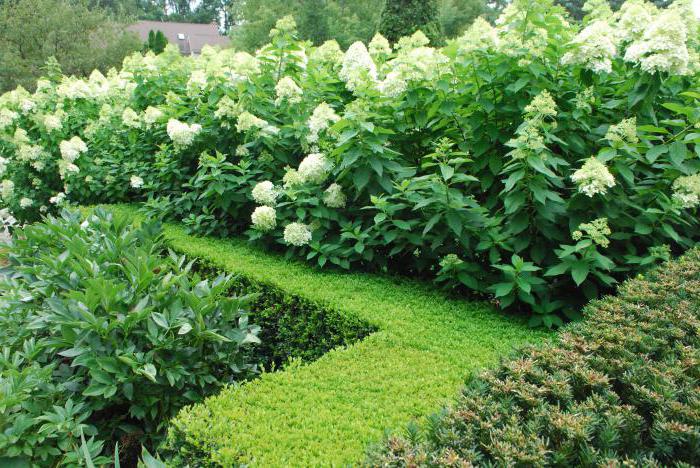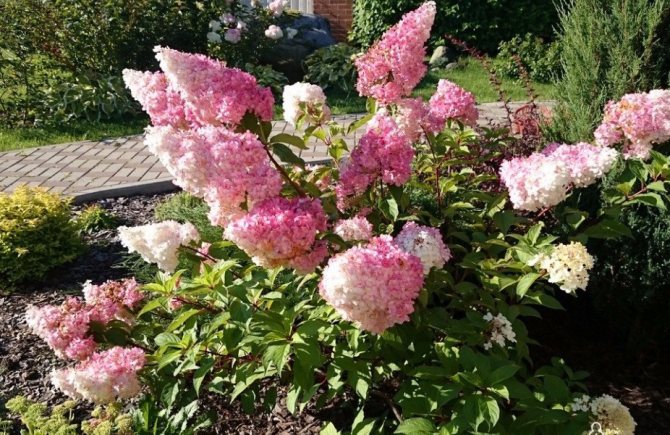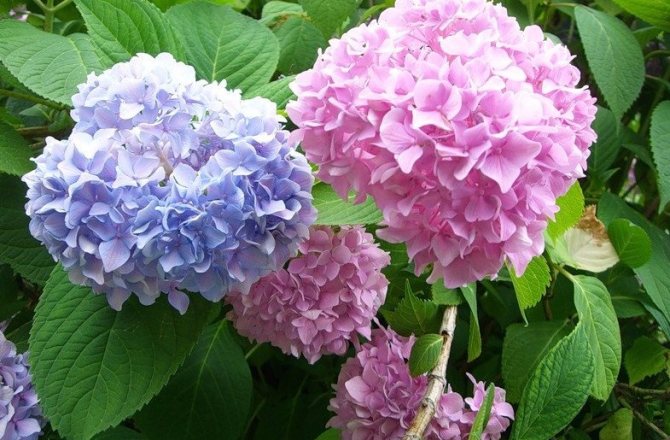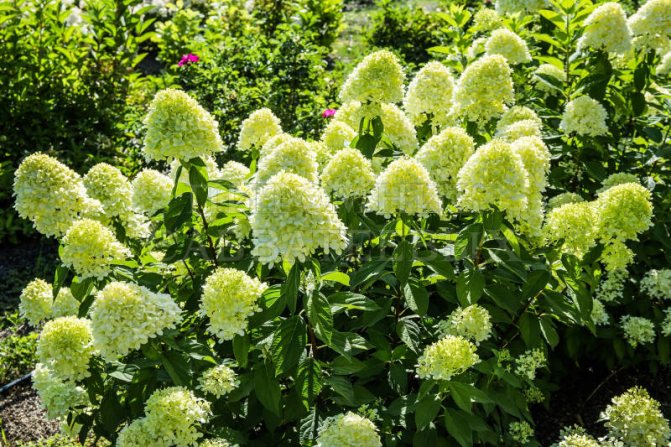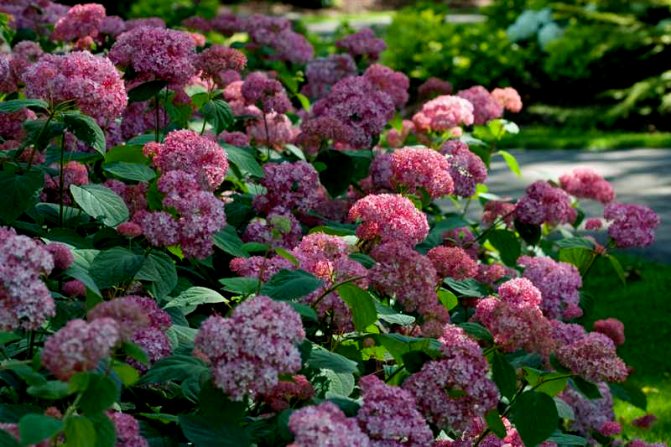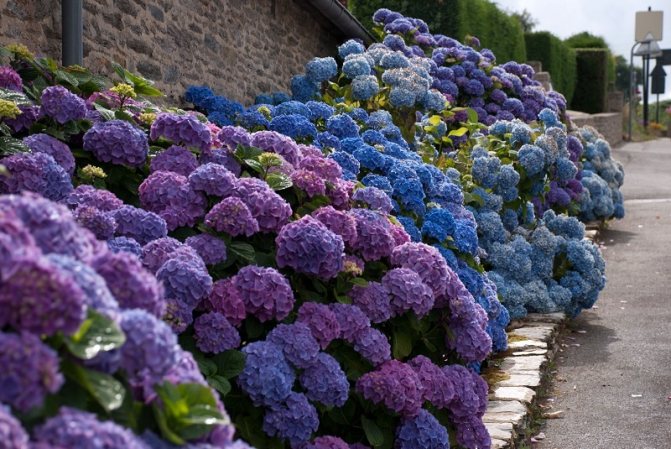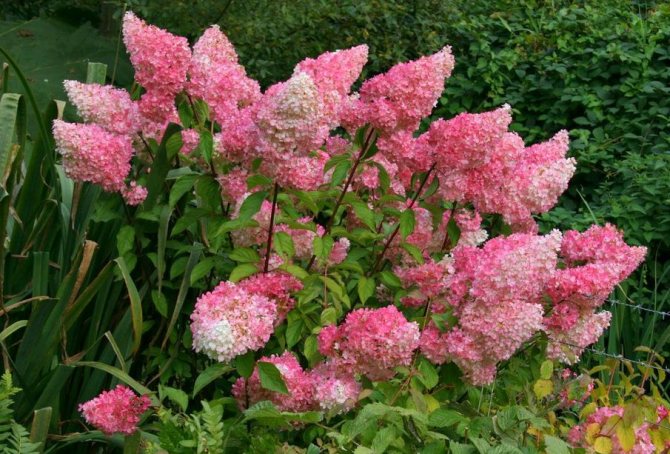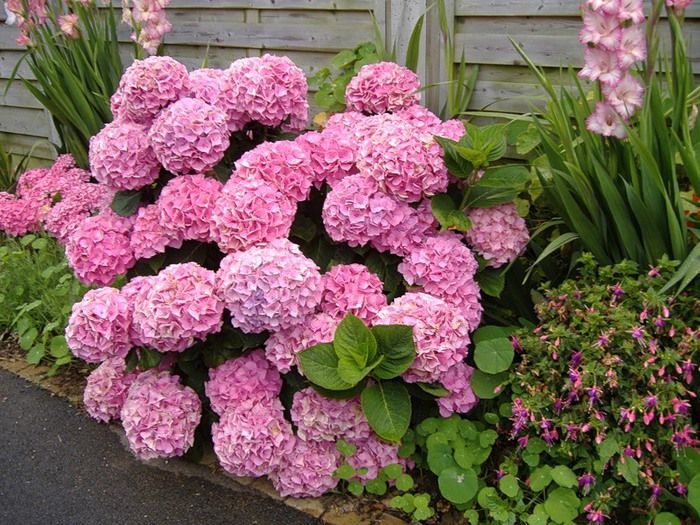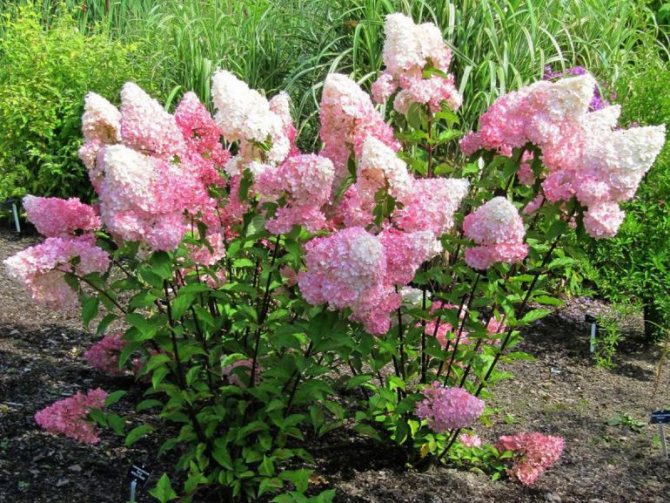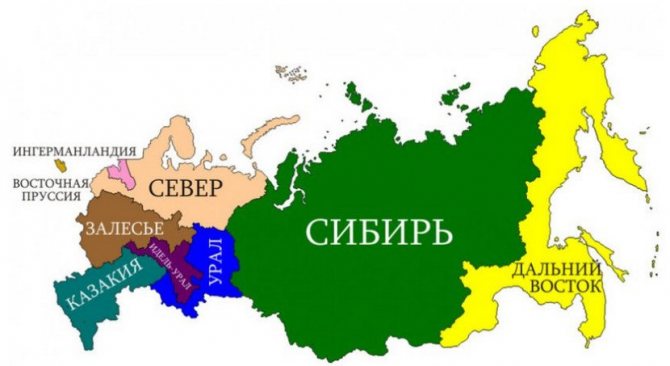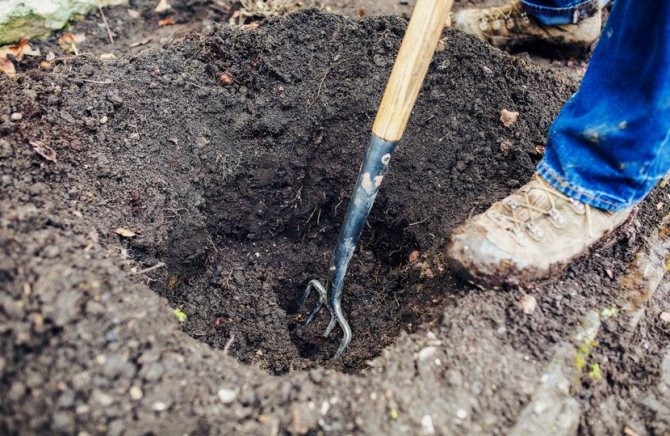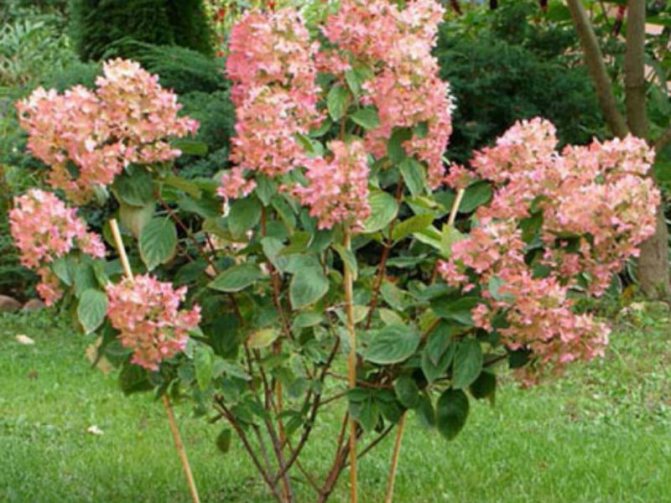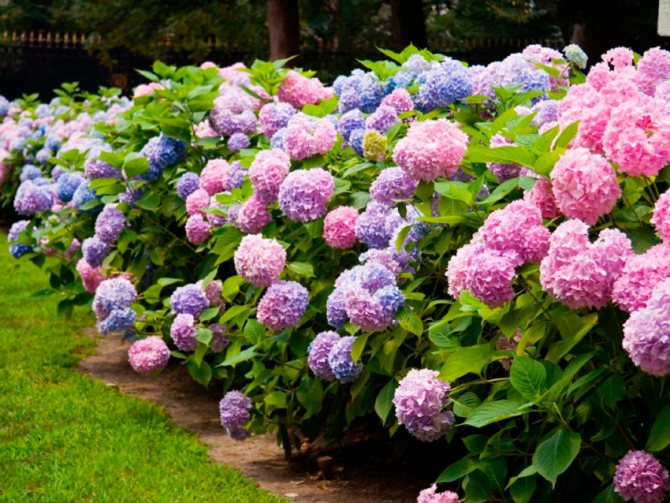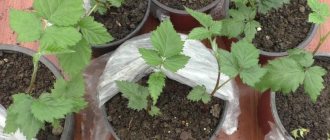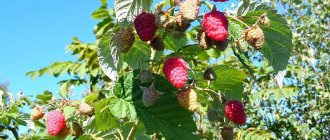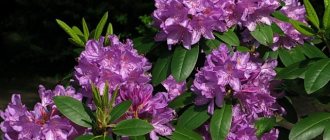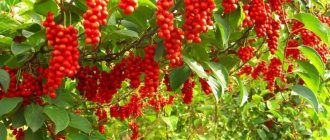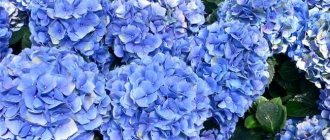Hydrangea is a wonderful ornamental shrubwhich blooms in early July. Lush hats of pink, snow-white, blue, or lilac flowers will adorn the garden until late autumn. Some gardeners consider the hydrangea a capricious lady., demanding to the conditions of planting and care, especially in Siberia, but this is not entirely true.
Let's figure it out together what varieties of shrubs you can grow without much hassle on your site in Siberia.
general information
Basically, the species diversity of the plant is more represented in the form of shrubs, small trees, and less - in the form of vines. They are divided into evergreen and deciduous varieties. Siberia belongs to the 3-4th climatic zone, which is characterized by the following conditions:
- Spring is late and short.
- Summers are humid, which is a great advantage for growing hydrangeas in Siberia. Most hydrangea species are moisture-loving and can hardly tolerate dry weather.
- Autumn is short, starting from mid to late August.
- Winter is long, 7-9 months.
For different climatic zones, you need to choose the right types of hydrangea for Siberia. Temperatures throughout Siberia range from -20 to -60 ° C in winter and 2 to 20 ° C in summer.
For successful cultivation, abundant flowering and reproduction, several rules must be observed:
- The soil is neutral or acidic.
- Moderate watering, Hydrángea is a moisture-loving flower. Lack of moisture reduces the quantity and quality of flowers.
- Fertilizers are added 3 times in spring-autumn:
- in the spring - when the buds open;
- during the formation of flowers;
- before shelter for the winter;
- The place is bright, but with a little shade during the day, without drafts.
- Ash, lime are prohibited in the form of dressings for hydrangeas, they neutralize acidic soil.
Shrub propagation
There are 5 methods of propagation of bushes: seeds, cuttings, layering, offspring, dividing the bush. The best method is grafting, which is common among gardeners. Green cuttings occur at the time of flowering buds. It is recommended to cut the cuttings from young hydrangeas. If you have an old shrub, anti-aging pruning is done. An important point is also the preservation of moisture in the tissues, since successful rooting depends on this.
Hydrángea (hydrangea) is a perennial, unpretentious plant of the Flowering division of the Hydrangea genus. It was brought to Europe for cultivation in the gardens of noble people. According to some versions, it got its name from the Latin derivative “hortus - garden”. Although this flower was not spared by the story of the strong mutual love of the botanist F. Commerson for one of the noble ladies named Hortense. Over time, the plant has spread to different climatic zones. Hydrangeas in Siberia are grown according to their own rules, which are different from cultivation in other regions.
Winter-hardy varieties of hydrangea for Siberia
The climate of Siberia is harsh, not all plants can be grown successfully, much less hydrangeas. Although you can pick from a huge variety of breeding varieties and species:
- Hydrangeas are large-leaved winter-hardy varieties for Siberia: Endless Summer, Forever & Ever, You and Me, Hovaria, SchlossWackerbarth.
- Treelike: Annabelle, Strong Annabelle, Invincibelle, Grandiflora.
- Panicle varieties: Silver Dollar, Pinky Winky, Vanille Fraise, Sunday Fresh Magical Fire, LimeLight, Unique.
The most frost-resistant varieties of hydrangea for Siberia are: Silver Dollar, Pinky Winky.
Silver dollar
Hydrangea Silver Dollar is a large-flowered, tall, unpretentious plant variety. The flowers are snow-white, connected in large cone-shaped inflorescences, which change color to pale pink towards the end of flowering. Shoots are erect, powerful, fast-growing, some specimens have a height of about 300 cm, on average, the height ranges from 150 to 200 cm.
Stems are well developed, branched. The branches of the current year are green, last year's branches are brown. Leaves are oval, pointed at the end, with small teeth, rich green color. Blooms from early to mid July to September.
Pinky winky
Pinky Winky is a species of paniculata Hydrangea, which has an unusual feature: the flowers are at first white, towards the middle of flowering they become a pale pink hue, then the color becomes dark crimson and at the end dark red. The stem is strong, branched, grows from 1.6 m to 2.2 m. It grows in width quickly to 1.4-2 m.
Leaves are oval in shape, pointed at the end, changing color from bright saturated green to purple. The first inflorescences appear in June, the last - mid-September - October. Pinky Winky hydrangea bushes can be grown outdoors in the southern regions of Siberia, in others they require transplanting for the winter in special containers.
How to prepare a bush for winter and protect it from frost
Hydrangea in Siberia requires shelter for the winter. Even the most frost-resistant varieties, which can withstand frosts down to -30 ° C, cannot withstand the winter cold of this region without a reliable shelter.
The plant is prepared for winter without waiting for the first frost. From the beginning of September, watering is completely stopped, and the lower leaves are removed so that the shoots begin to wood. Then, before the first frosts, all leaves are removed from the bush, except for the topmost ones, and the branches are carefully pulled together with a rope.
The bush is wrapped with covering material in several layers... It is bent to the ground and fixed with stones or bricks, and covered with spruce branches on top and covered with dry foliage.
Frame shelters are very popular. The bush is pulled together with a rope and wrapped in a covering material. A wire or mesh frame is made around it.
It should be 10 cm higher than the plant. The frame is filled with dry foliage, and the top is covered with a waterproof material - roofing felt or film.
Treelike hydrangeas in Siberia
Most gardeners prefer to grow hydrangeas in Siberian gardens of tree-like varieties, they are most resistant to disease and severe frosts. They are unpretentious in the choice of soil and require pruning of old shoots in the spring. A feature of tree varieties is: the fewer shoots, the larger the brushes.
Annabelle
Variety Annabelle - large up to 25 cm white inflorescences that begin to bloom from June-July to late August - early September. In height it reaches from 120 cm to 150 cm, in width up to 350 cm. It safely tolerates temperatures down to -28 0 С, in the middle zone of Siberia it needs to be transplanted into a pot and a basement.
Strong annabelle
Garden hydrangea in Siberia is one of the most common plants used in landscape compositions for summer cottages. Strong Annabelle has an interesting dome-shaped or hat-shaped inflorescence. Blooming, the inflorescences combine a shade of mint and snow, by the middle of flowering - snow-white, by the end - light green. The stems grow in height up to 1 m 50 cm, in width from 100 cm to 1 m 30 cm. The leaves are oval, dark green in color, remain so until the first frost. Belongs to the 4th zone of winter hardiness, tolerates frost down to -34 ° C.
Invincibelle Spirit
The best hydrangea variety for Siberia, its middle zone is Invincibelle Spirit. A variety that can withstand frosts down to -36 ... -38 ° C. It has one feature: the deeper and more often the shoots are trimmed, the larger the inflorescences are from 18 to 30 cm.
The variety was bred relatively recently in the United States and was registered in 2010. Inflorescences of deep pink color change their color depending on the flowering period to dark pink, raspberry. It blooms luxuriantly from mid-June to September.The stem is branched, growing in height from 0.9 m to 1.3 m in width up to 1.5 m.
Grandiflora
Hydrangea Grandiflora is a tall plant from 2 m to 3 m. The peculiarity of the variety is the late blooming of leaves and sterility of inflorescences. This variety is not grown by the seed method. The flowers are large, up to 30 cm, at the stage of inflorescence formation they have a delicate creamy shade, gradually turning into white and by the end of flowering acquiring delicate pink tones. The hydrangea variety is resistant to severe frosts in Siberia down to –30 ° C.
Top dressing hydrangeas in the fall
They begin to prepare hydrangea for wintering in the fall. During the period of bud formation, the shrub is fed with phosphorus-potassium fertilizers; before wintering, it is useful to add five to ten kilograms of mature compost or humus under the bush.
What else to feed hydrangea? Gratefully hydrangea reacts to feeding with solutions of fermented milk products diluted with water, such mixtures contain the lactic acid bacteria and yeast it needs.
In the fall, it is useful to spray the plant with tincture of stinging nettle, this will saturate it with trace elements and increase winter hardiness.
The hydrangea will tell the attentive gardener exactly what elements it lacks. With a lack of potassium, burns appear at the edges of the leaves, the need for nitrogen feeding is signaled by a general yellowing of the leaf, and if the leaf becomes purple, it is necessary to feed with phosphorus.
Panicle varieties of Hydrangeas for Siberia
The specific feature of panicle hydrangea is medium-sized trees with elongated-oval leaves, pubescent. Small flowers form large clusters with a pleasant aroma.
Vanilla Fresh
Vanilla Fresh stems are erect, which stretch up to 1.5 m. The brushes are cone-shaped, with a "chameleon" color. The first flowers on the brushes are white, over time they acquire delicate pink tones, fading - dark shades from raspberry to burgundy. Flowering lasts 2.5-3 months, from mid-July to September. The variety requires a good winter shelter or a transplant for the winter in a container. Vanilla Fresh seeds have a low germination rate - up to 30%.
Sanday Fresh
Hydrangea Sunday Fresh is a shrub from 1 m to 1.2 m high, up to 1 m wide. The branches are bent, light brown in color, strong, rarely break under huge flowering brushes. The brushes are large, reminiscent of the Vanilla Fresh variety, the inflorescences have a rolling color: from pale pink to white, by the end of flowering they turn dark crimson. In favorable conditions, flowering begins in June and ends at the end of August.
Medical Fire
Hydrangea variety, optimal for conditions in Siberia due to its frost resistance. The bush grows up to 2 m in height and 100-150 cm in width. Blooming inflorescences resemble a flaring flame: white - pink - bright red.
Read also Beautiful awnings made of wood
Limelight
An ornamental variety that grows up to 1 m 80 cm in height and 1 m 20 cm in width. The brushes are large, lemon-colored, fading, they are painted in a pale pink shade. Begins to bloom from early July to the second decade of September. The bush is compact, with a wide spreading crown, requires shaping pruning, after which flowering is enhanced. The hydrangea variety LimeLight for central Siberia requires shelter for the winter, the lowest temperature at which the shoots of the plant freeze is –30 ° C.
Unique
Inflorescences are large, 25-30 cm, hanging from the branches. They begin to bloom white, towards the end they acquire a pale pink tone. The bush reaches 2 m, 1-1.2 m wide. It blooms for 60-75 days, from July to September. The variety is frost-resistant up to –30 ° C.
Preparing for winter
Large-leaved hydrangea As a preparation for winter, additional watering will be needed in the fall to build up strength.
Before the autumn frosts, the seedlings need to be spud 25-30 cm, add garden and coniferous humus, cover the bushes with agrofibre.Before real frosts, the bush is completely covered with straw (dry foliage), covered with a box, and wrapped with agrofibre on top.
In this case, the large-leaved shrub will overwinter well, and most importantly, the flower buds that have already been laid will remain.
Tree hydrangea in the fall, branches are cut off at a height of 30-35 cm from the surface of the earth; mulch the bush with dry foliage, sawdust, needles.
In an adult plant, branches are additionally thinned out. For the most part, one increment is left on the trunk.
Quite fragile twigs of an adult panicle hydrangea for the winter it is worth tying so that they do not break under the weight of the snow. There is no need to cover her.
The paniculate species is cut in the spring, each branch is cut into 2-3 knots. Dwarf varieties - to a height of 30-35 cm, high - up to 1 m.
Hydrangeas - care and preparation for winter:
Large-leaved hydrangea in Siberia
Large-leaved hydrangea varieties are often called garden hydrangea, successfully grown in Siberia. They are distinguished by their unpretentiousness to growing conditions and soil selection. They withstand the winter of central Siberia, are late flowering - from August to early November.
Endless summer
The garden hydrangea, which was created as if for the gardens of Siberia, can withstand temperatures down to -25 ° C. Inflorescences are large, spherical, from white to lilac-blue. Bush height up to 4 m, width up to 1.5 m.
Forever & Ever
The bush is low, up to 1 m, spreading in width up to 0.8 m. Inflorescences are spherical, bloom in blue, gradually changing color to dark purple, bloom in August and until the end of September. Growing in central Siberia requires shelter for the winter or transplanting into a pot, withstands up to –25 ° C.
You and me together
The compact bush grows up to 0.8 m, the branches are slightly lowered. The inflorescences are round in shape, depending on the acidity of the soil, they have a color from white to pink or blue. The leaves change color from green to yellow-red and brown. Flowering occurs at the end of July - October.
Hovaria
Hydrangea of the Khovariya series in the gardens of Siberia requires a transplant for the winter in a container. It is also important to comply with storage conditions - humidity, coolness, a dark place. The flowers are spherical, up to 25 cm in diameter, blue-violet in color. It grows in height from 2 m to 4 m. Cannot withstand air temperatures below -18 ° C.
Schloss Wackerbart
Hydrangea Schloss Walkerbuff winters in the southern part of Siberia in the open field at temperatures from -23 to -28 ° C. It is better for the variety to make an air-dry shelter for the winter, then the probability of hydrangea survival will increase in harsh conditions. The plant is up to 1.3 cm in height, the flowers change color throughout the entire flowering. On one branch there may be multi-colored inflorescences. They begin to form from a pale green shade, turning into a creamy pink, eventually darken to a purple (dark crimson) color with a blue center. They begin to bloom in mid-July, finish forming new inflorescences in the month of September.
The petioled hydrangea has gained particular popularity in the last few years in Siberia. This type of lianas, reaching 10 m in height, is successfully grown in the southern and middle part of Siberia.
Spring work with hydrangea
With the establishment of positive daytime air temperatures, overwintered hydrangeas can be gradually opened. Removing the shelter must be done in stages, giving the plant time to adapt to new living conditions, while providing it with sufficient ventilation. The final release of the plant from the insulating materials is carried out after the threat of recurrent frosts has passed, preferably on a cloudy, windless day.
After wintering, it is necessary to inspect the shrub, remove all frozen, damaged shoots. If pruning was not carried out in the fall to update the bush, it is done in March-April, guided by the same principles. In early spring, pruning of the bush can be done quite strongly, this will contribute to the formation of powerful shoots with large inflorescences. As a general rule, last year's shoots, on which the flowering of the shrub will mainly occur this year, are not cut off, with the exception of weak and damaged branches.
Frost-resistant varieties and types of hydrangea
Many Siberian gardeners know that this luxurious plant can be used to decorate a backyard.Some hybids tolerate cold temperatures down to -45⁰C in an open flower garden and do not wither. This applies to frost-resistant paniculate varieties:
Such small shrubs reach heights of up to 60-70 cm, produce lush cream, lemon, light pink, greenish-white or purple-red inflorescences, perfectly withstand severe Siberian frosts. If you choose other varieties of ornamental shrubs, they, of course, will survive the harsh long winter, but they are unlikely to please with flowering.

Not only panicle hydrangea is ideal for planting in cold Russian regions and Siberia, but also some frost-resistant tree varieties:
- Invincibelle;
- Grandiflora;
- Sterilis;
- Invincibel Spirit;
- Annabel.
Sprawling low bushes grow up to a maximum of 1-1.5 meters. They release large spherical inflorescences that delight the eye and thin out the pleasant aroma from early summer to late autumn.
Subject to all agrotechnical rules of care and planting, ornamental garden hydrangea will actively grow in Siberia, delight with luxurious flowers, splendor and a pleasant delicate aroma.
The plant looks great both in single plantings and in large shrub plantations, quickly adapts after being introduced into the ground, tolerates prolonged frosts without losing its high decorative characteristics.
Variety selection rules
It depends on the correct choice of the variety whether the shrub will take root in the harsh Siberian conditions or not. There are about 30 types of hydrangeas, most of which will never grow there. And local gardeners will have to admire them only in the photo. Here are the best hydrangea varieties for Siberia:
There is a chance that weaker plants will be able to withstand frosts down to -35 degrees and you can try to start planting them. But you need to know that if they survive the frost, such plants will no longer be able to bloom.
If you follow the procedure for growing hydrangeas in Siberia, planting, care and reproduction will be simple. The first steps to take is to choose a seedling, as well as a suitable time and place to plant it. Work order:
In order for the shrub to bloom, special care is not required for it. Growing hydrangea paniculata in Siberia, planting and caring for frost-resistant varieties, includes pruning, feeding and preparing for winter. Since the plant loves water very much, due to the dryness of the earth, the quality of flowering may deteriorate. Plant care:
Description of the spirea flower, its main varieties and varieties
Any frost-resistant plant needs a special shelter that will protect it from severe frosts. To make the hydrangea easier to winter, it needs to be prepared for this. A frame is installed around the bush and covered with a film. This will protect the plant from cold winds. The roots are insulated with manure, on top of which a layer of leaves and spruce branches is laid.
A good insulation is snow, which not only protects the plant from frost, but also moistens the soil. Snow is laid under the bush in a thick layer.
Chickens are counted in autumn, and garden plants - in spring, according to the results of their wintering. It is not enough to plant and grow your favorite plant; in the harsh climatic conditions of Siberia, it is equally important to preserve it. Hydrangea, like a real woman, although it looks like a gentle creature, has a solid margin of safety and is not able to decorate a Siberian garden for many years. Of course, a prerequisite for the safe wintering of hydrangeas is the observance of agricultural techniques during planting and care throughout the year. However, considering the question of how to prepare hydrangea for winter in Siberia, it is necessary to plan a certain additional set of autumn activities.
Choice of soil and place for cultivation
In order for the hydrangea to endure the difficult climatic features of Siberia, to bloom profusely, as in many photos on the Internet, it is important to choose a suitable place in the garden or flower garden before planting it.
Southern culture, does not tolerate direct rays of the sun, needs diffused lighting and protection by higher tree crowns. Close to large plantings, it is also not worth planting, so that other stronger plants with developed rhizomes do not take all the nutrients and moisture from the soil. It is advisable to set aside a calm place for the flower near a high hedge, which will become a protection from the winds.
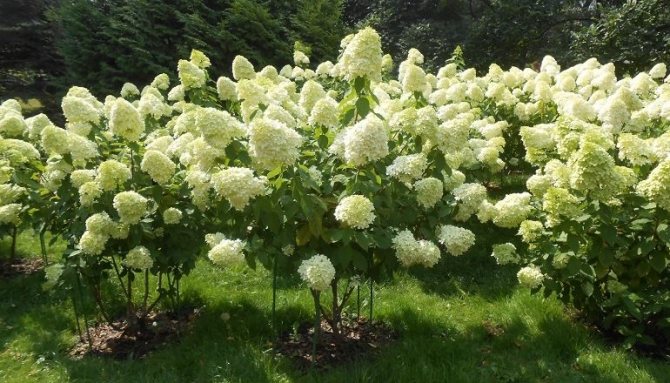

Frost-resistant large-leaved hydrangea and other varieties growing in Siberia do not tolerate an alkaline substrate and lack of care, therefore, before planting them, prepare the soil by mixing in different proportions:
- coarse river sand;
- peat;
- humus;
- compost;
- black soil;
- leafy ground.
Flowering plantings love a slightly acidic environment with a pH of 5-5.5. To acidify the earth, a few spruce needles are poured into the holes prepared for seedlings.
Landing in open ground
Given the rather rapid growth of the shrub, seedlings no older than 2-3 years of age should be transferred to the ground.
When buying, choose bushes with a developed root system. Choose a place for planting in advance, prepare the ingredients for the earthen mixture and the necessary fertilizers.
Preparation of planting material
Hydrangea paniculata and treelike reproduce well by cuttings... Experienced gardeners advise using cut branches for propagation of varietal plants.
Before planting, it is advisable to fill the seedlings with water for 2 hours.
Choosing a comfortable place
It is advisable to pick up enough illuminated place, without prolonged exposure to direct sunlight... In hot climates, shrubs are planted in the shade to keep the leaves from burning in the sun.
Summer in Siberia is short, there are few sunny days. Hydrangea growing in the shade will not give active growth, the flower stalks will be weak.
When buying a varietal plant, immediately find out the height and diameter of an adult shrub. If several plants grow nearby, the distance between the bushes should be at least a meter.
Moisture-loving shrubs will really like a place in the garden where a lot of snow accumulates in winter... The gradual melting of snow in spring will allow the shrub to accumulate moisture reserves in the root system.
Planting a hydrangea seedling in spring:
Landing
For planting you will need a hole 60 × 60 cm in size, which is better to dig in advance and water well (1-2 buckets of water, depending on the aridity of the region). The diameter of the hole should be twice the diameter of the root ball of the seedling.
Hydrangea loves acidic soil. Mix equal parts peat, sand, garden compost and coniferous soil.
Complex alkaline fertilizers, as well as ash, lime, are not used for this plant.
For disinfection and additional acidification of the soil, colloidal sulfur can be added to the prepared earthen mixture (1 teaspoon per bush).
Pour a little earthen mixture at the bottom of the hole, then put a seedling in it, and fill it with a nutrient mixture along the edges. The root heel of the shrub should be 1-2 cm deeper, or be at ground level, but not higher.
After planting, spray the bush with an immunostimulant, water generously... As soon as the water is absorbed into the soil, thoroughly mulch the root circle.
For this, rotted needles, peat, crushed bark, sawdust of coniferous trees are suitable. It is advisable to shade the seedlings for a couple of days.


The shrub loves acidic soil and moisture, after planting, mulching is necessary
How to choose quality seedlings and where to start planting
It is best to purchase a green bush that is already 5 years old in a specialized garden center, nursery or private flower garden. The earthen lump of the seedlings should be moistened.They begin to cultivate it in early spring, as soon as the frost stops. If the purchase was made in the winter, then the bushes are stored in a cool, well-ventilated cellar until they are planted in the ground. Healthy material should not have rotten shoots, damage to the crown, yellowed leaves.
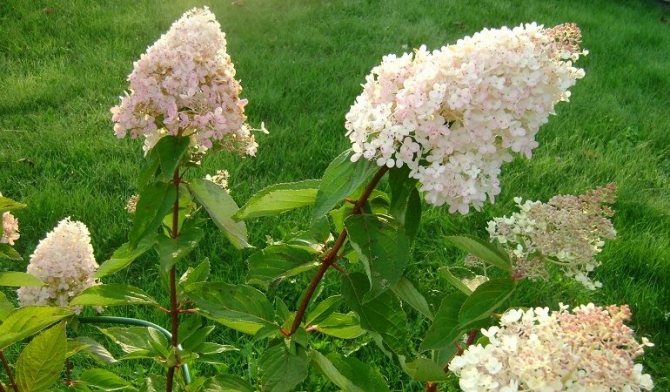

So that the seedlings quickly take root, take root well and do not die in the first months, wide pits are prepared for planting them so that the entire land ball can fit. A pit 50 × 50 cm is suitable for small young hydrangeas. A larger hole 80 × 80 cm will have to be dug for an adult plant. The day before work, several buckets of clean water are poured into the pit. After complete absorption of moisture, a little humus, sifted sand, turf, peat, pine needles are added to the seat.
Experts recommend immediately fertilizing the soil with a mixture of potassium sulfate (25 g), superphosphate (65 g) and urea (25 g). The plant will quickly die if fed with lime. This is strictly prohibited.
Choosing a place for planting and preparing the soil
An illuminated area is suitable for culture. However, it should not be exposed to direct rays for a long time. Siberia is characterized by short summers with few sunny days. If you plant a hydrangea in the shade, it will not grow well. In this case, the peduncles will turn out to be weak.
When purchasing a plant, you should immediately inquire about the height and diameter of the crop. If you plan to plant several hydrangeas nearby, you should observe an interval of at least 1 m.
The moisture-loving bush needs a lot of snow accumulation in winter. As it melts, the culture will be saturated with liquid.
The plant is distinguished by its exactingness to the composition of the soil. Hydrangea does not tolerate alkaline soil well. Therefore, it is recommended to plant it in a slightly acidic environment. The composition of the soil should include leaves, sand, turf, peat. In this case, the plant will bloom well.
Landing rules
Before planting a young hydrangea in Siberia, its roots are slightly shortened, as shown in the photo by experienced gardeners who know all the nuances of caring for an oriental beauty. All excess shoots are cut off, leaving vegetation only up to 5-6 buds. Then the bush is instilled in, but do not sprinkle it heavily with soil, leaving the neck of the roots visible.
Hydrangea does not like to have its roots deeply buried, but they should not remain in the open air. In order for rooting to be successful, after planting, the soil is re-watered and mulched with a mixture of peat, autumn leaves and needles to maintain a certain level of moisture.
Read also Do I need to mow strawberries for the winter


In order for the culture to successfully take root, it is advisable to protect it from the active spring sun and gusty winds in the first months. In a strong shade, the bush will simply rot, and under the bright sun, its leaves and buds will gradually fade. The ideal conditions for a beautiful hydrangea are well-diffused lighting, when the flower is under the sun in the morning and in the evening, and during the day it is reliably protected from the heat in the shade.
Hydrangea types: paniculate, tree-like, large-leaved
First, it is worth listing the types of shrubs, each of which is widely represented by different varieties:
- large-leaved (Hydrangea macrophylia);
- paniculate (Hydrangea paniculata);
- tree-like (Hydrangea arborescents).
There is one cultivation technique for the listed species. The differences lie in the methods of pruning different types, the need to cover large-leaved hydrangea bushes for the winter, and feeding options.
The large-leaved plant has recently changed its status as a home potted plant., and moved to the garden. Its cultivation will bring more trouble to its owners, but experienced gardeners will cope with this task quite well.
It is the large-leaved variation that can decorate your favorite garden with huge blue or crimson caps.
Large-leaved hydrangea forms inflorescences only on overwintered branches.New stems from the root will bloom the following year.
It is not cut off, but must be covered for the winter.for the beauty to spend the winter in comfort. In the spring, last year's inflorescences are carefully cut, just above the first living bud.


Large-leaved hydrangea
Round white inflorescences of tree hydrangea by autumn they will gradually become salad. It is the most common species that migrates from neighbor to neighbor.
Each branch comes from the ground, the shoots of the current year are blooming. It does not require too much attention, it simply multiplies by layering, tolerates pruning well.
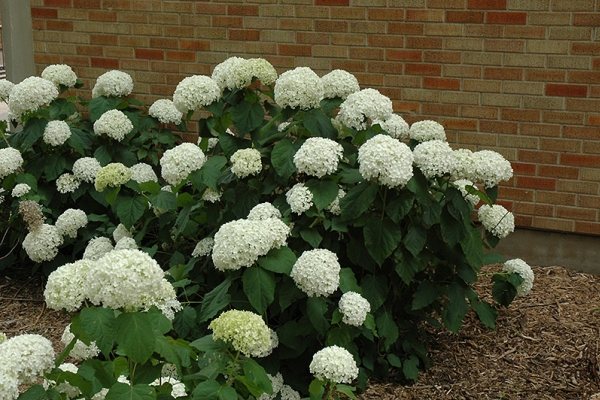

Hydrangea
Panicle hydrangea differs from the tree-like elongated shape of inflorescences, a different structure of the bush. The paniculata has much fewer shoots, but each has several branches ending in peduncles.
The branches of a new growth are blooming. In autumn, its inflorescences do not turn green, but turn pink. The bright color will remain until the first frost.


Panicle hydrangea
Growing hydrangeas by seeds
Tiny hydrangea seeds cultivated in small containers have excellent vitality. Of course, this is a rather long and laborious process of obtaining healthy seedlings. The first shoots appear only after 2 months. To speed up this process, experienced growers pre-soak the flower seeds so that they hatch. For this, a fungicide powder, a solution of Fitosporin or potassium permanganate is suitable.
Sowing work is convenient to carry out using small transparent cups or peat tablets. They are filled with pre-prepared soil from sifted river sand, black soil and peat. In Siberia, the cultivation of seedlings of the Asian flower begins in the fall, and the planting of hydrangeas in open ground is carried out a few years later in March-April. It is not necessary to plant seeds deeply into the ground. I just sprinkle them with fine sand.
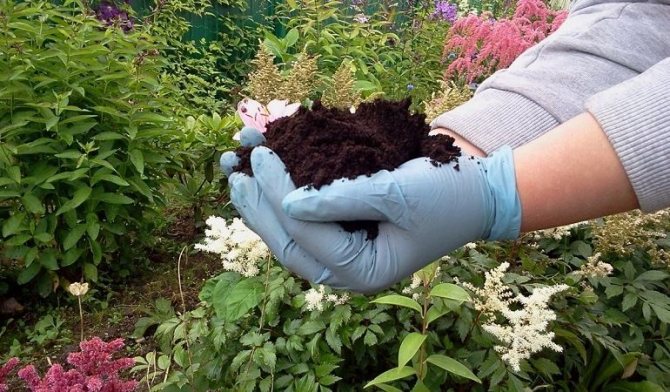

If the cultivation of seedlings is planned in special peat tablets, they are placed in a box with a deep tray and 2-3 seeds are sown in the center of each container. Crops enter the heat faster, at a temperature not lower than 20⁰C. They arrange a mini-greenhouse for them, covering peat tablets or cups with transparent polyethylene and conducting periodic airing. The first green leaves hatch closer to December. The hydrangea will get to a permanent place in the flowerbed no earlier than after 3 years.
In winter, hydrangea seedlings require additional lighting and mineral fertilizing.
As soon as the upper earthen layer dries up, it must be watered abundantly. It is advisable to periodically spray the first shoots of an exotic flower in the winter heating period with a spray bottle. The picking of seedlings is carried out in the spring. Each bush is transplanted into an individual wide container. After that, they can be periodically taken out to the balcony for hardening, but at night they can be put back in their original place in order to protect them from cold and drafts.
As you can see, planting hydrangeas with seeds and caring for the first shoots in Siberia is a long and rather laborious process. Young healthy three-year-old shoots are ready for transplanting. Each bush should have a height of at least 40-50 cm. Flower seedlings, if properly prepared, tolerate the cold winter months well. They are bent down, fixed in this position and covered with a pillow of dry leaves and peat. Covering material, for example, polyethylene or spruce branches, can be put on top.


Planting instructions
To plant a hydrangea correctly, you must follow the instructions and recommendations:
- prepare a place in the spring, for planting you need to allocate areas of 0.5 × 0.5 × 0.5 m;
- the distance between the bushes should be 2.5 m;
- cut the roots, shoots, leaving a few buds;
- the roots of the plant must not be buried; it is necessary to water abundantly and cover the soil.
Preparing the pit for planting
When we figured out the landing site, you need to prepare a hole:
- Soil and size are taken into account: small flower seedlings grow into large bushes, so the fertilized pit should be large enough - 50 × 50 cm or more.
- For large seedlings, a pit 80 × 80 cm is made, up to 60 cm deep. It all depends on the size of the roots.
- 3 buckets of water are poured into the pit and left overnight to soak the earth. In the morning, peat is added with sand and fertilizers (proportion - 2: 1: 1: 2). Organic fertilizers and minerals are also added there. Pine needles are suitable for added acidity. The mixture completely fills the hole.
- Hortense does not like lime and dies because of this.
- The last stage of preparation is pruning shoots and roots. The roots are shortened, and the shoots are pruned to 6 buds.
Reproduction of frost-resistant hydrangea by cuttings
Ornamental hydrangea is very unpretentious in terms of vegetative reproduction. Together with pruning the bush, cuttings are also carried out. An adult flower has enough sprouts to reproduce. Cuttings 2-3 cm long are cut from below at an angle, and straight from above. Their rooting is carried out in a small body made of film. The planting sprout is buried in moistened soil enriched with peat, dry pine needles and sand. For the winter, it is dug up by the roots and transferred to the cellar.
In March, the flower is again planted in the garden bed, covering it with a high shelter (slate or film) before the second wintering. If desired, a metal wire or mesh frame is installed around the bush, a covering material, for example, roofing material, is pulled over it, and the plant itself is thrown with dry leaves. For the final transplant in open ground, the bush will be ready only by next spring.
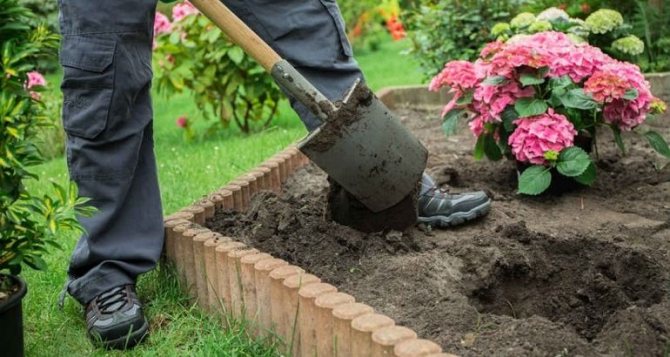

Planting winter-hardy varieties
First of all, you need to prepare a pit for planting in the spring. It should have dimensions of 50x50x50 cm.To plant a culture, you need to perform the following steps:
- Place the seedlings in the prepared grooves and sprinkle with soil.
- Place the root collar level with the ground.
- Water the plant.
- Pour a mixture of leaves, needles, peat. This will help keep the soil moist for longer.
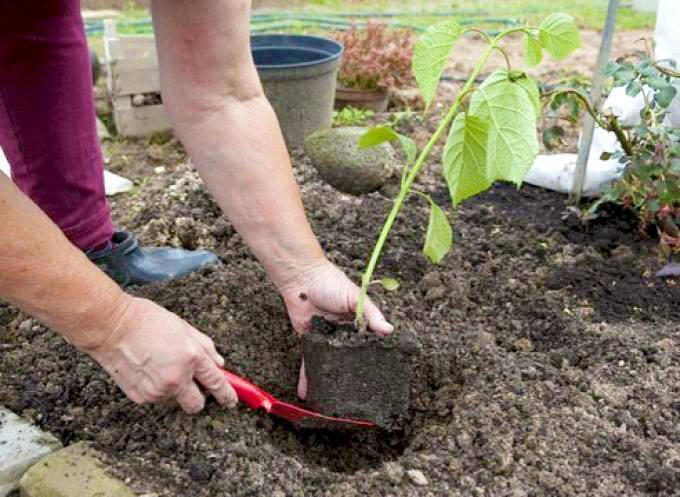

Watering and feeding
Hardy garden hydrangeas that grow in harsh climates love moist soil. They survive poorly in severe drought and require constant foliar spraying. In recent years, the summer months in Siberia have been quite dry, so special attention should be paid to watering the flower. The ground around the hydrangea should not dry out. In summer, with strong sunlight and insufficient moisture, hydrangea is watered daily.
With the onset of warmth, beautiful bushes are watered with nitrogen mixtures. At the end of August, to continue the flowering period and the formation of young shoots, the flower is fed with potassium phosphate preparations. Florist shops sell special feeds for decorative hydrangeas, which need to be bred twice a month (from spring to late summer).
Features of planting in cold climates
Saplings take root best at the age of 5 years.
In order for the hydrangea in Siberia to take root and grow well, planting must be carried out in a special way, taking into account the local climate. For this, a special microclimate is created: the seedlings must be protected from the wind and planted in medium acid soil, which includes turf, sand, leafy earth, etc. This provides suitable lighting.
Did you know?
Hydrangea is sometimes called French. This serves as a reminder that the entire Western world learned about the plant thanks to the first expedition around the world by the French.
Providing lighting
When the variety has already been selected, you need to determine its further place of residence. In Siberia with a harsh climate, you need to carefully approach the issue of planting hydrangeas. To begin with, protect the future plant from the wind - plant seedlings near a solid one.
Hydrangea loves light, but it does not tolerate the direct rays of the sun very well. It is better to choose a shaded place for the flower.
What should be the soil for planting
For bushes, soil is very important. Hydrangea does not tolerate alkaline soil, so the best soil for growing a plant is slightly or moderately acidic. This soil should be composed of sand, leaves, peat and turf. Then the plant will delight you with its abundant flowering.
Plant pruning
Experienced flower growers post many photos on the Internet demonstrating how the planting and careful care of hydrangeas in Siberia is carried out. The same applies to the process of pruning ornamental bushes. The formation of the flower crown begins in early spring. This is necessary to give the plant the correct shape, to activate the flowering process, sap flow and growth.


Obrazku begins only 3-4 years of growing season. Well-developed processes of frost-resistant hydrangea are cut off by 5-10 cm. At the same time, weak, thin, blackened and dry branches are removed. It is advisable to cut off three large shoots growing inward annually. Old flowers are cut to a crown of 5-7 cm. In autumn, after a period of active flowering, all dried inflorescences are removed.
Pruning hydrangeas in the fall
Pruning hydrangeas, like most other ornamental shrubs, is done every year, this stimulates the growth of new shoots and active flowering. The main pruning of the plant is done in the spring, but a number of gardeners practice strong pruning for renewal before winter.
With this pruning, all the growths of the current year are cut shortly, by 4-5 buds, all weak thin and damaged shoots, wilted inflorescences are cut to the base. This pruning stimulates the plant to release strong, simultaneously flowering shoots in the spring.
Regardless of whether the hydrangea is pruned for renewal in autumn or spring, foliage is removed from the plant before sheltering for the winter, which contributes to the ripening of the shoots and their better wintering.
Dangerous pests and diseases
Often, winter varieties of hydrangea infect various parasites. All kinds of mites and aphids especially destroy the culture. Fighting them is easy with acaricides or other chemicals. Insecticidal preparations help to quickly eliminate aphids. Without them, she eats up young shoots, which begin to dry out and rot. Powdery mildew is well helped by a solution of plain water and foundation. When yellow bloom and oily spots appear on the leaves and stems, the flower is completely sprayed with a solution of green soap or copper sulfate.
Is it possible to plant and care for panicle hydrangea in Siberia? The exotic lush appearance of hydrangea often alarms those who are engaged in gardening in Siberia: they doubt that it will be able to adapt to the harsh climatic conditions. However, there is a growing popularity of hydrangea paniculata in the design of dachas, gardens, household plots in Kemerovo, Omsk, Tomsk regions, Krasnoyarsk Territory and Altai.
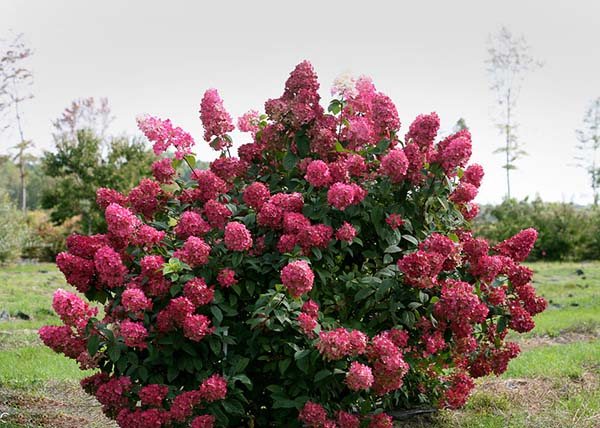

Unpretentious hydrangea paniculata: planting and care even for novice gardeners are not difficult. As an adornment of any estate, the abundantly flowering one and a half meter shrub with conical and spherical and pyramidal inflorescences reaching thirty centimeters looks self-sufficient and solemn.
The origin of hydrangea is the Far East, China and Japan: growing in humid climates, some species of wild plants are half the size of modern hybrids adapted to Siberia, and some reach the size of a ten-meter tree, the trunks of which are valued for white strong wood used in creativity.
Plant care
Treelike and panicle hydrangeas are not too capricious... In order for the plant to grow stronger and please with abundant flowering, you will need to follow simple rules:
- sufficient watering;
- root mulching;
- correct pruning;
- seasonal feeding.
The plant loves water very much, knows how to accumulate it... The very name of the shrub is translated as "A vessel with water". In summer, shrubs need 2-3 buckets per 1 bush, 3 times a week. In autumn - 2 times a week.
At the dacha, under a bush, you can pour acidified milk or whey. It is recommended to slightly acidify the water for irrigation in any convenient way.
For 1 bucket of water, you can add any of the proposed acids, the main thing is not to overdo it:
- 2 g citric acid;
- 5 g vinegar 9%.
Hydrangea and its varieties, planting and care:
The roots of the plant are located close to the surface, therefore dig up and loosen the ground around the bush carefully... It is useful to add mulch, humus, forest needles under the bush.
There are specialized fertilizers that are called “For hydrangeas”. If you can't buy them, you can use fertilizers for azaleas, heather, rhododendrons.
By adding iron preparations (iron chelate, iron vitriol), gardeners achieve a blue color of the inflorescences.
First time feeding large-leaved hydrangea is applied in the spring so that the plant forms healthy shoots. Second time - in June, for the formation of peduncles. Third time - during active flowering (August)to support the plant during next year's flower buds.
Top dressing with drugs is necessary for large-leaved hydrangea, paniculate and tree-like can do with organic fertilizers.


There are specialized fertilizers, which are called "For hydrangeas"
Description of popular varieties
Thanks to technology, the shades that change during the period of prolonged flowering have become more diverse, the panicle hydrangea already has dozens of species.
Hydrangea "Silver Dollar"
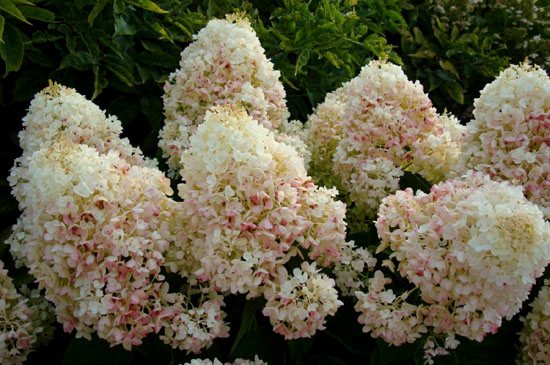

Perennial hydrangea paniculata "Silver Dollar" captivates with a cone-shaped, greenish tint at the base, yellow inflorescences turning into sterile white; in autumn it can acquire pink and lilac shades. Starting in July, Silver finishes blooming in September.
Hydrangea "Silver Dollar" is the leader among its representatives: spreading, reaching two meters in height and width, unpretentious to heat, shade and earth: it grows on loamy, slightly acidic lands and black soil. Due to the instantly depleting reserves of nutrients and moisture, it does not tolerate sand, and begins to wither.
Care, pruning
Leaving without sufficient watering is destructive: after applying top dressing, as well as at the time of bud formation, regular watering must be carried out. To retain moisture in the root zone, the plant is mulched.
"Silver dollar" tolerates pests as hard as possible.
Benefits of an unpretentious plant:
- upright shoots;
- cultivation in a container is possible;
- no garter required;
- flowers on almost every branch.
Pruning
With the help of timely pruning, the bush is given a shape that is appropriate for the plan of the landscape designer.
Pruning rules in caring for panicle hydrangea:
- Pruning hydrangea paniculata is carried out before the peak of sap flow. If the moment is missed, then pruning is carried out after the beginning of the blooming of the leaves.
- Thanks to correct pruning (in short, by cutting off last year's shoots), lush flower stalks are achieved.
Read also Rose canadian park wasagaming
If you haven't grown a gratefully blooming Silver, try decorating your garden with it.
Panicle hydrangea "Vanille fraise"
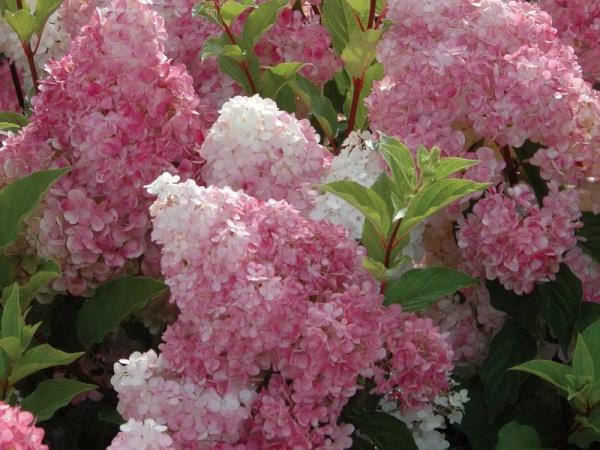

Panicle hydrangea "Vanille fraise" evokes admiration for the density and size of the pyramidal inflorescences. From the beginning of flowering - the flowers are white, then a pink border appears. Reminiscent of a delicious dessert, the two-tone Vanilla Fries cones combine white or creamy vanilla tips and pale pink bases that turn dark red towards the end of the season. The uniqueness of this variety is that white and red flowers grow at the same time.
"Vanilla Fries" represents winter hardy varieties of hydrangea. Even freezing at very low temperatures, it quickly recovers. "Vanilla Fries" is able to withstand frosts of 40 degrees Celsius, does not require special care in order to prepare for winter - shelters.
In gardening, when planting, the ability of "Vanilla Fraze" to grow up to two meters in a short period of time is taken into account.
Care, pruning
For fertilization, slurry, ammonium and potassium nitrate, superphosphate are used. Top dressing provides flowering for two years. Nitrogen fertilizers are applied only in the spring to avoid freezing of the plant and prepare it for winter. The plant is harmed by an alkaline reaction, therefore, ash, deoxidizing the soil, is not added as fertilizer.
The plant is shade-loving, the flower stalks become small in the sun. If there is too much sun, more watering should be provided.
In winter, fragile shoots are threatened by snow sliding from the roofs.
Pruning.
In the spring, during the awakening of living buds, both dry, old and frail shoots are cut off. Autumn pruning - the shoots are shortened by 4 knots to avoid frostbite and to stimulate their development for the next season.
To retain moisture at the roots, mulching is used.
In the spring, when the ground warms up, the compost is poured in a layer of up to 8 cm.
In landscape design, this decorative element will decorate the garden, because of its size, it is used in the middle or background. In mixborders, it is combined with different colors.
Having a standard shape, it retains space around itself for low colors.
When planting, it must be borne in mind that hydrangea will compete for moisture with a birch that has a superficial root system. Therefore, such a combination is used in coastal areas or on condition of drip irrigation controlled by soil moisture sensors.
With care, it is planted with spruces.
In conditions of urban gas pollution, it shows resistance to harmful influences.
Long-term "Vanilla Freise" is able to please up to 40 years.
protection against snow melting.
Hydrangea paniculata "Unique"


Hydrangea paniculata "Unique" was bred in the middle of the 20th century in Belgium. At the end of the 20th century, she won the Royal Award for excellent decorative qualities in the creation of hedges, as it is the largest among the varieties of the family (sometimes reaches three meters in height and five in width). It is the best choice for decorating large open spaces. Growing this panicle hydrangea will transform parks and gardens of the city into a kingdom of airy beauty and create a representative image.
Hydrangea "Unique" grows up to 20 cm per year. The average size is one and a half to two meters in height, three in width. The volume of the wide white cones reaches thirty centimeters. The size of the leaves reaches fifteen centimeters in length and eight in width.
"Unique" has strong shoots with red bark.
Blooming by the end of July, pleases with flowering until October.
The frost-resistant properties of this variety allow it to withstand frosts down to -30 ° C.
Care, pruning
Gardeners prefer this type of hydrangea to the garden panicle, as it is easy to plant in the open field and care.
- a calm place, protected from the cold;
- neutral or slightly acidic soil in partial shade;
- timely watering;
- pruning shoots preferably in the spring: old ones are removed, last year's are cut by 2/3 of the length;
- top dressing three times per season: during the formation of buds and twice during the summer with manure and other fertilizers (nitrogen is used in spring, potash and phosphorus fertilizers - in summer);
- prevention of diseases and pests (spraying with insecticides and fungicides, installing light and glue traps for insects);
- fight against diseases and pests;
- to cover the hydrangea in winter (in warm winter, they cover it with leaves and snow, in a harsh climate - they also add agrofibre cover and install a box, which is covered with boards).
Propagate paniculate hydrangea by dividing the bush and cuttings
Hydrangea cuttings are made in early June. Cuttings with five to six nodes are used, leaves are cut off from the lower ones and added dropwise. Cutting off 2/3 of each leaf, the cuttings are covered with glass containers.When planting in a greenhouse or at home at a temperature of 15-20 ° C, they regularly monitor the level of moisture, in a timely manner, in order to avoid decay, airing and watering with a weak solution of potassium permanganate.
How to grow a plant
Planting of a seedling "Unique" is done in two or three years, spring planting is preferable.
After each watering and rain, the soil is loosened by 5 cm. To prevent weeds from growing, the root zone is mulched.
Neighborhood with fruit trees is not recommended.
Of all hydrangeas, this one has the greatest drought resistance.
Overview of varieties of panicle hydrangea
The chic 1.5-2.5 meter pinky winki hydrangea also blooms from July to September.
The top of the loose Pinky panicle is white, the bottom is red; by the end of the season, new panicles continue to bloom.
The leaves of "Winky" turn yellow in the fall.
Frost-resistant hydrangea "Hydrangea paniculata" has inflorescences up to 25 cm, unopened buds look like beads, so the bush looks delicate.
The panicles change color, turning pink and then purple. As dried flowers, they are good for winter compositions.
Also to the late paniculate, blooming from August to October, belongs "Phantom".
It has a spreading crown and white or cream flowers with a wonderful lilac tint, turning pink by the end of the season.
"Phantom" has the largest inflorescences - up to thirty centimeters.
Late panicle hydrangea "Grandiflora" often grows in regions with a mild climate, blooms stably and luxuriantly.
Hydrangea "Grandiflora" several times a season changes the shades of large inflorescences as follows: cream - white - pink and red-green.
Hydrangea "Tardiva" blooms late - from August to October. Reaches a height of three meters.
Hydrangea "Tardiva" is distinguished by its increased frost resistance. Beginning to bloom timidly in July, blooms well in August. Chameleon "Tardiva" changes colors as follows: greenish - white - cream.
Kyushu panicle hydrangea is another popular variety. Panicle hydrangea "Kiushu" has a fan-shaped crown, its height is up to three meters. Its special value lies in its late flowering: the second half of summer until late autumn.
Prefers to grow on acidic soils, pleases with more abundant flowering.
Despite the variety of panicle hydrangeas, the basic rules for planting and care are the same. The landing rules for one are suitable for others: they are universal.
Care rules
Hydrangea, planted in Siberia, does not require much maintenance. But in order for the flower to be strong and healthy, you need to adhere to the basic rules and recommendations.
Watering
Hydrangea loves moisture very much. Drought can disrupt the growth and development of the flower. The plant is watered every 14-16 days with 1-2 buckets of water. In dry and hot weather, the bush is irrigated every week. In a rainy summer, 4-5 waterings per season are enough. The procedure is carried out in the morning or evening, when the sun is not so active. To help the plant survive the winter in Siberia, water-charging irrigation is carried out in the fall.
Hydrangea prefers soft and warm water. Experienced gardeners add 2-3 g of potassium permanganate to the watering can, which prevents the appearance of rot.
Pruning
Hydrangea growing in Siberia needs regular pruning. In the spring, the procedure is performed before the kidneys awaken. The best time is the second half of April. Shoots of tree hydrangea are pruned to 3 buds from the ground. Weak and growing inward branches are removed to give the desired shape to the shrub. The panicle hydrangea is cut differently - last year's stems are shortened by one third. In autumn, the faded inflorescences are cut off.
To rejuvenate the old bush, you need to cut off all the shoots at a height of 5-6 cm from the ground. Next spring, young branches will appear, and the decorative effect of the flower will be restored.
Important! Young hydrangea is not pruned, the shrub must be over 3-4 years old.
Top dressing
In order for hydrangea to bloom abundantly and magnificently in Siberia, it needs to be fed. For the whole season, the plant is fertilized 3-4 times:
- In early spring, early to mid-May.For each square meter of land, 20-25 g of urea, 25-30 g of superphosphate and 20 g of potassium sulfate are added. After two weeks, feeding is repeated.
- During bud formation. 60-80 g of superphosphate and 40-45 g of potassium sulfate are diluted in water and the plant is watered with the resulting solution.
- After flowering, 6-7 kg of compost or rotted manure is applied under each bush.
It is not recommended to use wood ash for feeding. It must be remembered that excess fertilizer will do more harm than good.
Shelter and preparation for the winter
Even the most cold-resistant hydrangea variety will not tolerate frost in Siberia without shelter. To prevent the plant from freezing, do the following:
- The shrub is spud with soil, and the trunk circle is mulched with dry foliage, peat, needles or rotted manure.
- The plant is wrapped in burlap or any other covering material. The stems are bent to the ground and the structure is fixed with stones, and the top is covered with sawdust, spruce branches or dry foliage.
- If the bush is large, then it is neatly pulled together with a rope. A wire frame is formed around it, which should be 8-11 cm higher than the flower. The hut is filled with dry leaves, and a film or roofing material is stretched over it.
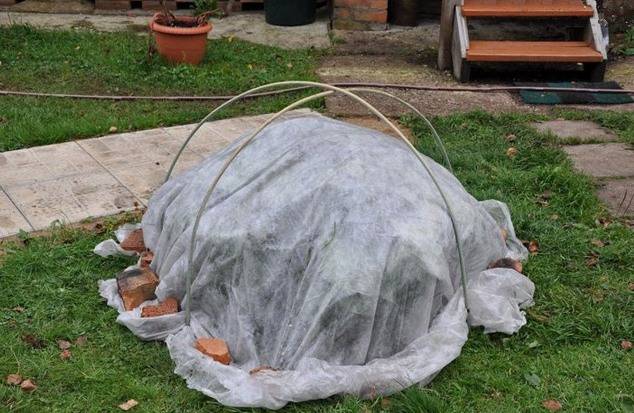

When snow falls, you can collect a snowdrift around the hydrangea, which will serve as additional protection. It will not only insulate the shrub, but also saturate it with moisture with the arrival of spring.
Reproduction
Planting in a sunny area, protected from the wind, will ensure the buds are open and beautiful.
Reproduction is carried out by layering, dividing the bushes, cuttings, seeds.
Of the presented methods, the most difficult is to get a sprout from seeds, the most common is cuttings. Reproduction from seeds is not justified: a flowering bush is obtained in four years, hydrangea does not always germinate from seeds.
In harsh weather conditions, it is best to grow hydrangeas in the spring, it will take root more easily over the summer. Planting in the fall requires special care - shelter for the winter.
An important point of care is preparation for winter: the best for a bush is to cover the root system. Preparing a seedling for winter involves the use of a covering cloth. Protecting the branches, make a snow-retaining cornice around the hydrangea. Correct pruning also saves from severe frosts.
Features of care in difficult conditions
Panicle hydrangea is considered a rather unpretentious crop, but when growing a plant in Siberia, certain features should be taken into account.
To ensure the full-fledged formation of a culture, it must be cut off in a timely manner. To do this, they are guided by the following recommendations:
- cut off all faded inflorescences in the fall;
- cut off the main shoots to the required height, and leave 3 buds on the side ones;
- to rejuvenate old bushes, branches are cut to 8 cm stumps.
Hydrangea is considered a moisture-loving crop, therefore it is forbidden to leave the soil dry. After watering, it is recommended to mulch the land. For this, sawdust and leaves are used.
To ensure a long and abundant flowering of the plant, it must be properly fed. A moderate volume of slurry can be used for this. Mineral fertilizers are also suitable. For 10 liters of water, you should use 25 g of funds. 3 buckets of the mixture are added under an adult plant.
During the season, panicle hydrangea is fed 4 times. This is done at the beginning of the movement of the juices, at the time of blooming, in summer and autumn during the preparation of the culture for winter.
Preparing for winter
In winter, a strong decrease in temperature is observed in Siberia. Therefore, the hydrangea must be covered. First of all, it is recommended to take care of the insulation of the roots. For this, you can use rotted manure. Dry foliage or peat is also good. These materials are laid on the ground in a thick layer.
In the winter season, the shrub can be insulated with snow. It not only protects the plant from the cold, but also saturates it with moisture.
Care problems
Common problems with growing hydrangeas include the following:
- Brown spots appear on the leaves... This is due to the development of gray rot.
- Roots are affected and the plant dries up... The provoking factor is white rot.
- Leaves are covered with white bloom... The cause is the defeat of powdery mildew.
Fungicides will help to cope with pathologies. They can be purchased at specialized stores.
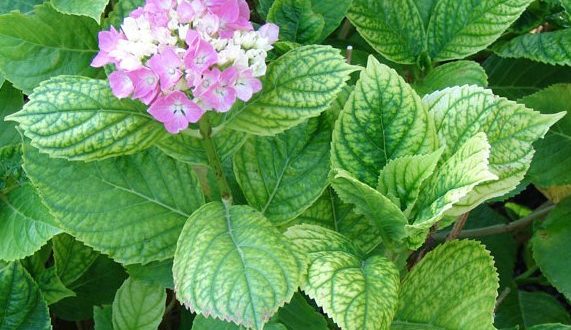

Chlorosis on hydrangeas is common in low temperatures
Panicle hydrangea in landscape design
Thanks to the use of this plant in landscape design - panicle hydrangea - they achieve beauty and harmony in small and large areas of the earth.
To give a wavy appearance to the site, three or more bushes are planted: a spreading shape, airy bloom allows you to create a feeling of joy, happiness to the inhabitants of the estate.
The composition of the hydrangea mixborder revives the severity of conifers, giving tenderness and airiness to their static appearance with lush flowering.
Pests and the fight against them
In the summer, hydrangea often suffers from pests of garden plants. Hydrangea is usually affected by spider mites and aphids.
Spider mites are small arachnids that feed on plant sap. You can see the tick only under a magnifying glass. On the shoots affected by the pest, you can see a cobweb that braids the youngest leaves.
Hot weather and low humidity contribute to the reproduction of spider mites. If the plant is infected with a tick, it is necessary to treat it with pesticides as soon as possible to completely destroy the pest. For this, drugs are used: acaricides or insect-acaricides.
Aphids on hydrangeas multiply in large numbers, which leads to drying out of the affected young shoots. Only insecticidal preparations will help to cope with this pest.
Hydrangea: description, photo
Hydrangea is a genus named after the sister of the prince of the Holy Roman Empire, who bore the beautiful name Hydrangea. The botanical name is translated from Latin as "a vessel with water". And this is not surprising, because the main property of the plant is an increased love for moisture. The birthplace of the hydrangea is Asia, mainly China and Japan. The inhabitants of Japan call the culture ajisai, which means "a flower like a purple sun."
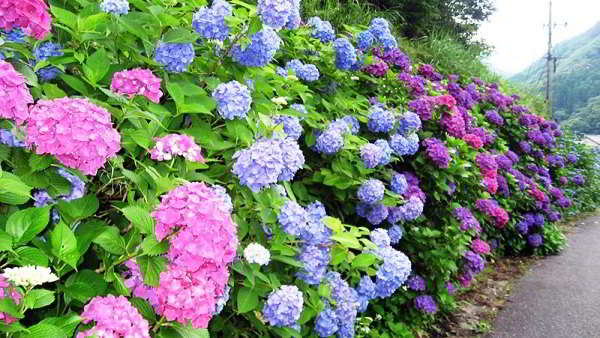

Whatever the name of the luxurious representatives of the genus Hydrangea, they have many faces. Some species are represented by shrubs, others by dwarf trees, and some are lianas capable of climbing up to 30 m on a support. In total, the genus includes 70-80 species, of which about a dozen representatives are used in culture.
Attention! All parts of the exotic contain glycosides, which, when decayed, turn into the strongest poison - hydrocyanic (hydrocyanic) acid. Be vigilant, keep children and animals away from this plant.
According to the botanical description, most hydrangeas are deciduous or evergreen shrubs with erect stems. Plant growth is from 1 to 4 meters, but there are also more compact forms. At the ends of the shoots, large caps of inflorescences are formed by the middle of summer. The form is paniculate, viburnum-shaped, shield-shaped. What visually looks like flower petals are actually overgrown colored sepals of sterile flowers. Each bud has 4 such false petals. Fertile flowers are very small and inconspicuous, concentrated on the crown of the inflorescence, sterile larger, located at the edges.
Most of the inflorescences are white and cream colored. But the large-leaved hydrangea has a unique feature to change the color of sepals, depending on the pH of the soil on which it grows. At high pH, the buds turn pink and lilac, and on an acidic substrate, the heads turn blue, due to the absorption of aluminum compounds.
The decorative period lasts until the end of the season. In varieties with fertile flowers, seed pods, divided into 2-5 chambers, ripen. The seeds are numerous and have a good germination rate.
On a note! The introduction of aluminum salts into the soil promotes the production of blue and purple inflorescences. If you add a solution of aluminum sulfate unevenly (from different sides of the bush), you can achieve the appearance of multi-colored heads.
Apply an oriental beauty to form bright groups. It goes well with other shrubs, low conifers. With the help of exotic, you can create a luxurious flowering pillow on a green lawn or a beautiful hedge, decorate the central part of a mixborder, the background of an alpine slide. Ornamental shrubs - rhododendron, holly - will become good neighbors for a southerner. From herbaceous plants, it goes well with periwinkle, hosts, ferns, ornamental grasses.
Pruning
The hydrangea bush should be shaped so that it always looks well-groomed. In autumn, after flowering is complete, it is necessary to remove the faded inflorescences.
In the spring, before the start of sap flow, it is necessary to cut off all the shoots from the tree-like hydrangea, leaving 5 buds each. The paniculate variety is cut a little differently - the main shoots are cut to the desired height, and the side shoots are reduced to three buds.
It is necessary to regularly rejuvenate old bushes, cutting off all branches and leaving hemp 7-8 cm - new shoots will appear very quickly.
Reproduction methods
Hydrangea can be propagated in four ways: by seeds, cuttings, layering and dividing the bush. In practice, cuttings and propagation by layering are most often used. Since during seed reproduction the varieties bred by breeders lose their aesthetic qualities, this method is rarely used. Breeding process:
- Seeds. Seed reproduction is a very long and laborious process. The soil is poured into the container and the seeds are sown. In this case, the seeds are not buried. To create a greenhouse effect, the container is covered with glass or a plastic bag. The soil is regularly ventilated and moistened. The first sunrises will appear in 3 weeks. They cannot be planted in open ground. The sprouts are grown for 3 years at home and only then are they planted in a permanent place.


Cuttings. For cuttings, shoots with leaves and three buds are used. The procedure is carried out in the spring with the appearance of the first buds. The shoot will retain moisture and stay alive if cut early in the morning. To prevent the shoot from wilting, it is placed in water and cuttings are cut. It is divided into 2-3 parts, leaving several leaves on each. The leaves located on top are pruned, and the lower ones are completely removed. Before planting, the cuttings are placed in a solution for 2 hours to stimulate root growth. Then the soil is thoroughly moistened and cuttings are planted in it. New leaves will appear in 30 days.- Layers. The procedure is carried out in early spring. The ground under the bush is carefully leveled and small grooves are made. The shoots located at the bottom are placed in the grooves and fixed with brackets. Young shoots will appear by the end of August.
- By dividing the bush. To propagate a hydrangea in this way, you need to dig up an adult bush. Its roots are cleaned of an earthen coma and divided into 2-3 parts, which are immediately planted in the ground.
Juniper strickta: description, planting, care and reproduction
Suitable species
Cold Siberian conditions can only be tolerated by some types of hydrangea, namely paniculate and tree-like. When choosing the right variety, it is very important to pay attention to its characteristics, especially you should take a closer look at the height of the bush, pay attention to the size of its inflorescences, as well as the flowering period.For the northern regions, it is recommended to purchase early flowering varieties of hydrangeas, since admiring the beauty of late flowering simply will not work as a result of the onset of too early cold weather.
Panicle hydrangeas have rather large inflorescences, resembling a cone in shape. It depends on the correct choice of the required variety whether you can admire the flowering of a lush hydrangea or not.
Today there are about thirty types of hydrangeas, most of which are simply unable to withstand severe frosts, which is why young plants should be purchased only from trusted gardeners.
Indoor hydrangea in Siberia planting and care at home
In addition to the species described for open ground, large-leaved hydrangea is grown at home. The hybrids of this exotic are compact, 60-100 cm tall. Inflorescences 10-15 cm in diameter are distinguished by an abundance of shades of white, pink, blue and purple. Pot culture is easy to cultivate.
All the requirements for the composition of the soil, watering, top dressing applied by hydrangeas are applicable to this variety. Contain pots at a temperature of 18-20⁰C in a constantly moist state. Spray the flower periodically. Lighting of moderate intensity, place exotics 2-3 meters from the south window. The addition of the full mineral complex twice a month will strengthen the indoor adzisai.
Advice! Use wide pots for the crop as it has a shallow root system that grows horizontally.
In one pot, the exotic grows up to 5 years, then it must be transplanted. The process is carried out by the transshipment method, not forgetting to pour a high layer of drainage into the container. It is convenient to combine the transplant with the division of the bush in order to get a few more individuals on the windowsill. To do this, the dug out bush is divided into parts. Make sure each section has growth buds and a strong root lobe.
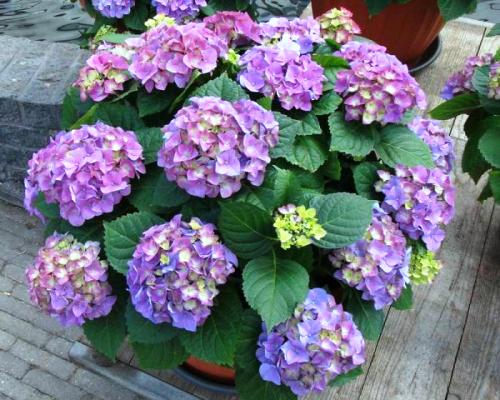

Indoor shrubs are cut very carefully, removing only wilted flower stalks and every fourth branch. Cut shoots can be used for grafting. Potted hydrangea is cultivated with the obligatory observance of the dormant period. As soon as the foliage begins to wilt, watering will reduce and reduce the temperature background to 4-9⁰C.
After 1.5-2 months, the dormant period will end, young leaves will appear on the shoots. Provide the crop with good lighting, raise the temperature, and resume abundant watering. An unpretentious large-leaved variety for the summer is taken out into the garden or on a shaded balcony, but it winters exclusively at home.
Conclusion
As you can see, growing hydrangeas in Siberia is not such a difficult process, the main thing is to follow the rules of planting and care, and then the oriental guest will certainly reward you for your efforts with her lush flower hats.
Features of the climatic conditions of Siberia
Siberia is one of the coldest places in the world. The high mountains surrounding it do not allow warm sea winds to penetrate there, and the famous Siberian frosts sometimes reach 50 degrees. “Birds freeze on the fly” is just about the Siberian winter.
Autumn and spring in Siberia are short, the transitions from cold to warm are made very quickly. This circumstance cannot but affect the rules for growing flowers and ornamental shrubs in Siberia.
One of the plants that grows in Siberia is hydrangea. Despite the fact that hydrangea is a heat-loving shrub, it comes from the south, and in Siberia it mainly grows at home, some gardeners manage to grow hydrangea in the open field.
Of course, not all hydrangea varieties are suitable for this. In total, hydrangea has about 40 varieties, and most of them cannot be grown in Siberia. But some types of panicle and tree hydrangea tolerate Siberian frosts well, and with proper care they delight gardeners with their abundant flowering (see photo).
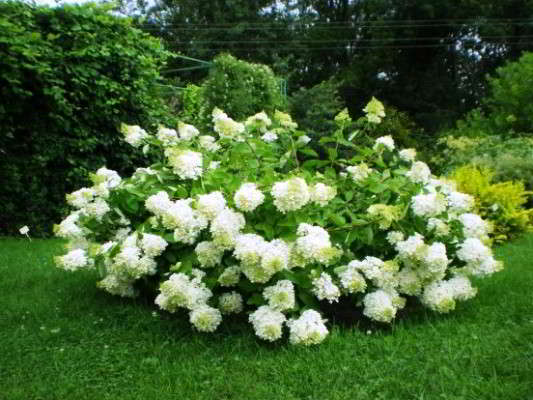

Cold-resistant varieties of panicle hydrangea include:
- Silver Dollar. This hydrangea variety blooms with large white flowers, collected in oblong inflorescences. By autumn, the plant changes color from white to pink. This variety blooms from July to the end of September, the flowering is very abundant and decorative. The Silver Dollar hydrangea is almost three meters high;
- Phantom has the largest flowers, the shade of which changes during the season - at first the inflorescences are pale beige, and in the fall they turn pink. This variety reaches a height of 2 meters;
- Pinky Winky is covered with bicolored inflorescences - they are pink underneath and white at the tips. This hydrangea grows up to 2.5 m ;,
- Vanille Fraise also changes the color of the inflorescences during the season - at first its panicles are snow-white, and by the end of the season they become almost burgundy;
- Lime Light, on the other hand, changes color from greenish to white. This variety reaches a height of 2.5 m and has long shoots.
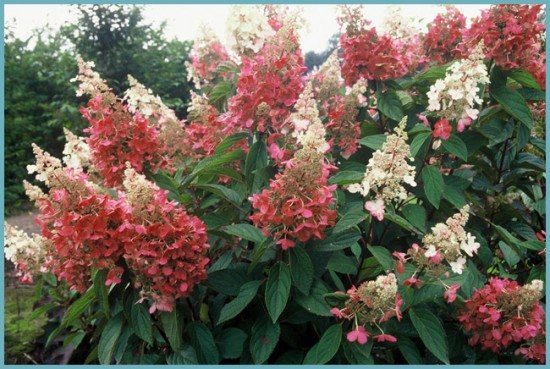

The varieties of tree hydrangea that can be grown in Siberia include the following:
- Strong Annabelle - a bush with rounded leaves and the same rounded white inflorescences, which reaches a height of up to 1.5 m;
- Candiflora is a plant up to 2 meters high and has a large lush crown. This variety blooms from July to the end of September, large inflorescences have a sandy hue;
- Annabelle is perhaps the most successful variety of tree hydrangea for cultivation in Siberia; Frost-resistant, grows quickly, blooms profusely, has large white inflorescences in a cream shade;
- Invincibelle is also a very good and relatively new variety of tree hydrangea, very resistant to frost and cold. It has long, strong shoots with white inflorescences. Blooms all season, until frost.


All these varieties of hydrangea do well in the harsh conditions of Siberia. However, in order for them to grow normally, bloom and develop, any hydrangea needs proper care. What kind of care they should be provided with, we will try to figure it out.
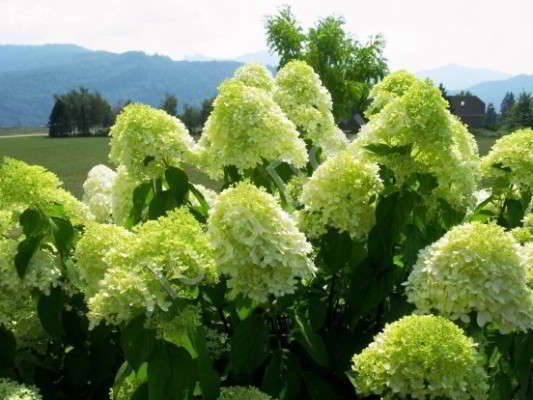

Diseases and pests of garden hydrangea
The plant is resistant to diseases and pests, however, may be amazed:
The most beautiful hydrangea plant is excellent suitable for single and group plantings
, goes well with low conifers and looks great against the background of stones. With proper planting and caring for it, you can admire the magnificent flowering and be proud of your flower garden all summer until autumn.
Garden hydrangea
Hydrangea is a magnificent shrub. It can decorate a summer cottage with itself if it is placed next to a gazebo, a place to relax, a veranda. It is famous for the beauty of its spherical inflorescences, which can be white, lilac or pink in color. How beautiful the tree hydrangea can be in Siberia, the photo clearly demonstrates. It blooms for a long time: from June to October.
Description of the plant
The plant is perennial. It belongs to the Hortensia family, which has more than eighty species. The shrub reaches a height of 1.5 to 2 meters. When flowering ends, the fruit-boxes are formed. The seeds are ripened in them. A plant native to China, it is very thermophilic. Only a few of its varieties are suitable for breeding in Russia. The tree-like and "eternal summer" variety is very beautiful. The latter variety is unique due to its colors. They can be blue or pink in color, depending on the acidity of the soil.
Reproduction of hydrangea
The plant propagates in several ways: by cuttings, layering and dividing the bush. To better take root in Siberia, it is bred with layering. This is done very simply. It is enough to prepare a hole in advance, then bend the one-year shoot of the bush to the ground and press it down so that it does not rise. You can dig it a little. In this case, it is necessary to leave its upper part at least twenty centimeters. A year later, the already rooted shoot must be cut off from the main bush.Then it, along with a clod of earth, is transferred to a new place, where it will grow constantly. There should be a distance of one to one and a half meters between the plants. First starts at age 4.
watering and pests
Hydrangea requires regular feeding. In Siberia, planting and caring for this ornamental flower shrub includes the introduction of peat (during the planting of seedlings in spring), humus. Once per summer, the plant must be watered with slurry and complex mineral fertilizer. The shrub can be supplied once a month with a weak solution of potassium permanganate. Superphosphate is introduced in the fall.
Since hydrangea is very moisture-loving, planting and caring for it in Siberia are accompanied by regular watering. The plant prefers fertile soil, sour, loose. The site should be chosen bright and protected from the winds. In the spring, they prune last year's shoots to make them lush.
There are pests that hydrangea suffers from. In Siberia, planting and care involves protecting the plant from spider mites and aphids. To do this, you need to monitor the condition of the leaves of the shrub, if necessary, treat it with special chemicals or collect insects by hand. Downy mildew can be distinguished among the most dangerous plant diseases.
In order not to freeze hydrangea in Siberia, planting and care require special training. The plant is covered. The soil around the bushes is covered with sawdust or peat, the layer should be from six to seven centimeters. In the spring, the soil must be cleared of mulch, but not completely. Do not worry if the upper part of the shoots suffers from frost. They will grow back quickly over the summer.
Follow-up care
After planting hydrangeas, they should be properly looked after, otherwise they will not live the time allotted to them. Growing a plant in itself is not the most laborious, and many varieties are so hardy that with proper care they can live for more than 30 years.
- Watering. Watering the plants is extremely important. The soil should always be moist, but it is not worth overfilling. After each watering in harsh conditions, it is recommended to sprinkle the soil with dry leaves or sawdust. Mulching is extremely beneficial for garden hydrangeas, because it allows you to retain moisture in the soil without forming crusts on it. It is best to use water for irrigation at room temperature; many experts even recommend that it be defended for several days. Sometimes you can add a little manganese to the water, which is used for prophylactic purposes against a number of diseases, but you should not be overzealous here either.
- Top dressing. In order for the bush to be strong and hardy, and its growth even more accelerated, it is recommended to feed it. Top dressing also has a good effect on abundant flowering. Hydrangeas should be fed with special fertilizers no more than 4-5 times per season. From organic matter, manure fertilizers or nitrogen compounds can be used; mineral fertilizing is also recommended. You can feed the plant when the cold weather recedes, then when it picks up buds, during flowering and, finally, after dropping the leaves.
- Pruning. You should only cut hydrangeas as needed, you should not get carried away, because the plant can suffer greatly from this. In the fall, dry branches with foliage are usually pruned, but in the spring it is recommended to do a more thorough pruning. Branches can be shortened up to five buds, in rare cases and more if necessary. On panicle hydrangeas, shoots are removed to the third bud, while it is undesirable to cut the main ones.
Is it possible to plant and care for panicle hydrangea in Siberia? The exotic lush appearance of hydrangea often alarms those who are engaged in gardening in Siberia: they doubt that it will be able to adapt to the harsh climatic conditions.However, there is a growing popularity of hydrangea paniculata in the design of dachas, gardens, household plots in Kemerovo, Omsk, Tomsk regions, Krasnoyarsk Territory and Altai.
Unpretentious hydrangea paniculata: planting and care even for novice gardeners are not difficult. As an adornment of any estate, the abundantly flowering one and a half meter shrub with conical and spherical and pyramidal inflorescences reaching thirty centimeters looks self-sufficient and solemn.
The origin of hydrangea is the Far East, China and Japan: growing in humid climates, some species of wild plants are half the size of modern hybrids adapted to Siberia, and some reach the size of a ten-meter tree, the trunks of which are valued for white strong wood used in creativity.
When and where to plant it.
Of course, you can plant a hydrangea, as well as other plants, both in spring and autumn. But as far as Siberia is concerned, it is better to do it in the spring. This is done so that the seedling can take root well over the summer and get used to a new place where it will have to grow for many years. During this time, the seedling will also have time to grow up and endure the winter well. It is in Siberia, when a plant is planted in autumn, there is a high probability of losing it, because it can simply freeze out.
Likewise, in the spring, hydrangea can be planted only when the frost has completely stopped, and there will definitely not be a repeat one. This mainly happens in the second half of May. This is all necessary because although hydrangea is frost-resistant, it can hardly endure temperature fluctuations, especially when it is young, or even just planted.
Regardless of the variety or species, any hydrangea loves acidic soils most of all. If it is not acidic enough on your site, then to correct the situation, special fertilizers are applied twice a year. this should be done in early spring, before the hydrangea has bloomed. And in the fall, when preparation for winter begins. It is the composition of the soil that plays a very large, and practically the main role in the cultivation of hydrangeas. After all, if the soil on your site does not suit it, then it will not develop correctly, and even more so it simply will not bloom.
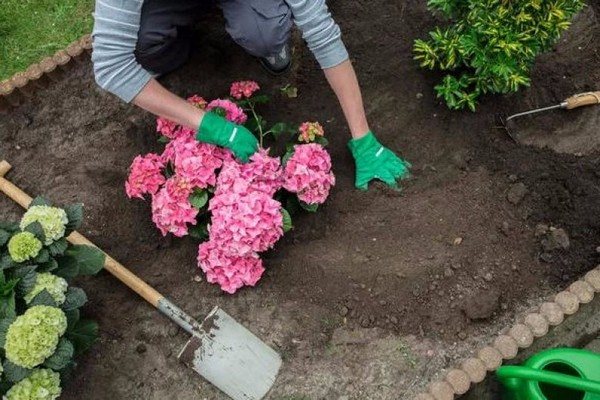

Also, the right choice of place has a very important role in planting shrubs. Since hydrangea does not really like transplanting, the choice of place must be taken with full responsibility. Hydrangea is very fond of light and warmth, so the area on which it will grow should be well illuminated by sunlight, only these should not be direct rays, but a little scattered. Although this shrub can easily adapt to almost any conditions, so if it grows a little in the shade, it will not affect flowering in any way.
Mostly hydrangeas are planted as a separate plant. it is rarely planted in a flower arrangement. And all because the shrub is very large and all other plants will very quickly be lost against its background. Hydrangea is often planted as a hedge and is often used in landscaping.
After you have chosen the place where the hydrangea will grow in the future, the first step is to prepare a hole for planting. It must be at least half a meter long and high. this size is simply necessary for the root system to develop well and have enough space. Before lowering the seedling into the hole, you first need to add special fertilizers to it, or simply mix organic matter with minerals. Also, there must be sand in the soil of the mixture, thanks to it the soil will be lighter and looser.
Before lowering the seedling into the hole, its roots must be shortened a little with a sharp tool. And the shoots are best cut off a little. Planting a hydrangea seedling should not be too deep. The root collar should be practically on the ground.After you have lowered the plant into the center of the planting pit, it must be carefully covered with earth, and then tamped well. And after you have done this, the newly planted plant must be watered with warm water. After all this, the land under and around the bush is best mulched, and peat is best suited for this purpose.


Choosing seedlings
When you choose a seedling, be sure to pay attention to the soil in which the hydrangea grows - the earthen ball should be moist and uniform, and not have extraneous inclusions. Also inspect the shoots of the plant - they should be long enough, easy to bend, and not have any signs of damage or wrinkles.
It is better to buy a hydrangea seedling just before planting. If, for some reason, it is not possible to plant it right away, then before planting it is necessary to store the hydrangea in a cool dry place where there is a possibility of airing.
Reproduction of hydrangeas
Reproduction of hydrangeas can be carried out in different ways - by seeds, layering, dividing the bush, but the most optimal is to propagate the plant by cuttings. Cuttings take root best of all, which are cut off when buds appear - in Siberia this happens towards the end of July.
Cuttings are best taken from young plants, they take root faster and easier. It is preferable to cut the cuttings from the side shoots that are in the lower part of the plant. As a rule, such cuttings have good large buds, which is very important for subsequent rooting.
Experienced growers advise to cut the shoots early in the morning, because in this case moisture remains in them, which also contributes to better rooting.
It is very simple to get a cutting - for cut shoots, you need to cut off the upper part, on which there is a bud, and cut the remaining shoot into 2-3 pieces, depending on its length. Each cut should have several leaves. The lower leaves must be removed, after which the cuttings are placed in water. If you add a little honey to the water, the roots of the cuttings will appear faster.


The cuttings should be planted in a moist nutrient mixture of sand and peat and covered with jars, creating a greenhouse effect for them.
After about a month, the cuttings will take root, and new leaves will begin to appear on them. After that, banks can be withdrawn from them.
With good shelter, rooted cuttings can endure the winter, however, in Siberia, it is preferable not to plant them in the fall in open ground, but to store them until spring in a dry, cool, well-ventilated room. The cuttings must be watered, they need moisture.
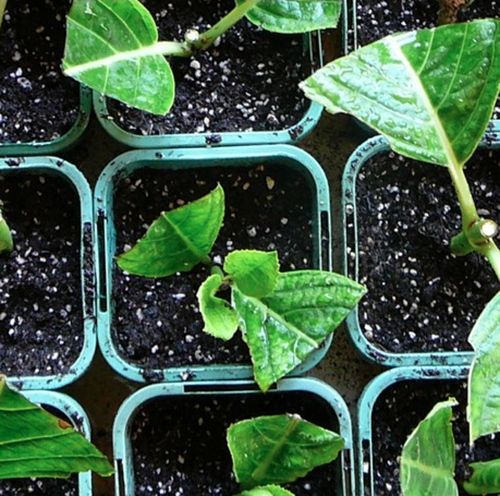

In the spring, rooted cuttings should be planted in the garden so that they grow and become strong. After the seedlings finally adapt and grow, they can be transplanted to a permanent place.
Observing these simple conditions, you can grow a magnificent hydrangea in Siberia, which will delight you with its flowering all summer.
Is it possible to plant and care for panicle hydrangea in Siberia? The exotic lush appearance of hydrangea often alarms those who are engaged in gardening in Siberia: they doubt that it will be able to adapt to the harsh climatic conditions. However, there is a growing popularity of hydrangea paniculata in the design of dachas, gardens, household plots in Kemerovo, Omsk, Tomsk regions, Krasnoyarsk Territory and Altai.
Unpretentious hydrangea paniculata: planting and care even for novice gardeners are not difficult. As an adornment of any estate, the abundantly flowering one and a half meter shrub with cone-shaped and spherical and pyramidal inflorescences reaching thirty centimeters looks self-sufficient and solemn.
The origin of hydrangea is the Far East, China and Japan: growing in a humid climate, some species of wild plants are half the size of modern hybrids adapted to Siberia,and some reach the size of a ten-meter tree, the trunks of which are prized for the strong white wood used in art.
Choice of place and conditions of detention
Regardless of the variety, all hydrangeas prefer moist, acidic soils. You can increase the acidity with special fertilizers, which must be applied twice a year - in the spring before flowering, and in the fall before the plant leaves for the winter. This circumstance is very important - if the hydrangea soil does not fit, the plant simply will not bloom.
The choice of location does not really matter for the seedling - hydrangea can grow in bright sun or in partial shade, this circumstance practically does not affect flowering.
Wintering plants
In order for the hydrangea bush to take root and winter well, you should purchase zoned plants grown in your region.
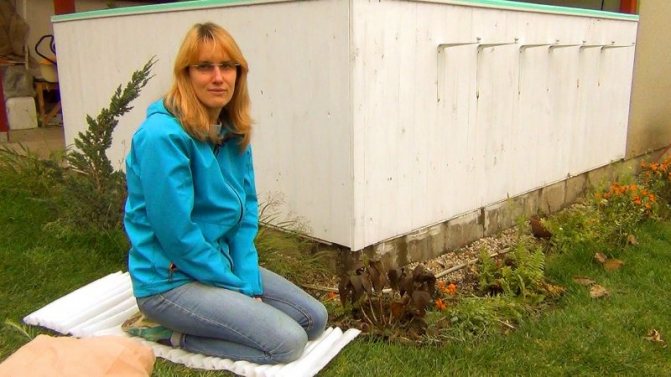

You should know that the bush reaches its bloom in 5 years. Then it becomes resistant to cold and can withstand Siberian winters.
The most cold-resistant is the panicle hydrangea. It can withstand frosts at -35 ° C, it is enough just to cover the root system with mulch (near-trunk circle). Young plantings are covered more thoroughly.
- For this, spruce legs, lutrasil and other covering materials are used.
- Rotted manure, peat, dry grass and leaves are used as a shelter.
- After a snowfall, the bushes are covered with snow. In addition to warmth, such a shelter will provide the plant with moisture after the snow melts.
- Before the shrub is insulated, its sanitary pruning is performed. Remove dry inflorescences and broken branches.
Garden hydrangea: photos, types, varieties
Most types of hydrangeas are shrubs, but there are vines and small trees. All of them have beautiful large or small leaves, and flowers collected in paniculate or corymbose inflorescences. All inflorescences are located at the tops of the shoots and have sterile or fertile flowers. Most often, their color can be white, pink or blue
.
Among them, only tree hydrangea and paniculate hydrangea are grown as perennial plants in the gardens of central Russia.
Hydrangea tree - photo
The shrub, which grows up to one and a half meters in height, has large oval leaves, the length of which reaches 20 cm. Slightly pubescent leaf plates are distinguished by a heart-shaped notch at the base and jagged edges along the edges. From above they are green, and from below they have a bluish tint. Large sterile and small fertile flowers are collected in corymbose inflorescences, which bloom in the first half of July.
Most suitable for planting in the garden the following varieties of hydrangea tree-like:
- Variety "White House" is a bush with a height of one to one and a half meters. At the ends of its shoots, large thyroid inflorescences are formed, consisting of snow-white sterile and creamy white fertile flowers.
- InvincibellSpirit grows up to 0.9-1.2 m. Its large inflorescences consist of sterile flowers. At first, they have a bright pink color, and over time they fade to light pink.
- Variety "Incrediboll" is a bush that reaches a height of 1.2-1.5 m, and has large spherical white inflorescences.
- Heis Starburst is a short bush with slender shoots that can break under the weight of large inflorescences. The inflorescences consisting of double flowers reach 25 cm in diameter.
- The Annabelle variety blooms with white sterile flowers, which form large inflorescences with a diameter of up to 25 cm.
Hydrangea paniculata - varieties, photo
Panicle hydrangea differs from tree hydrangea in inflorescences, which consist of large sterile and small fertile flowers, and grow up to 20-25 cm in length
... During flowering, they can change color. For the first time days, the petals of flowers are white, after a while they acquire a pink tint, and by the end of flowering they turn green. Large leaves of paniculate species are distinguished by an ovoid or elliptical shape. Below they are heavily pubescent, and slightly above.
Garden varieties bloom from June to July, and bloom for a long time. Among them are:
What varieties are suitable for Siberia
Paniculata and treelike hydrangeas take root best in the cold. They are not picky, they winter well without any shelter.
New variety of panicle shrub Limelight has an interesting feature. The buds first have a greenish tint, then bloom with lush, snow-white panicles, and in the fall they turn pink blush.
Compact new Phantom variety, also winter-hardy, is characterized by a very abundant flowering.


Winter-hardy variety Phantom
Variety Vanilla Fries very quickly forms a large bush, up to 1.5 m high. By autumn, the white caps gradually turn red.
Planting hydrangeas
As a rule, the hydrangea is planted as a single planting, on the lawn or not far from the entrance to the house - it is very decorative, and other plants will be lost against its background.
Having chosen a place for planting hydrangeas, you need to dig a sufficiently large hole (about 50 x 50) so that the roots of the seedling are not cramped. Fertilizers for hydrangea need to be added to this hole (or just mix mineral fertilizer with organic fertilizer), and add a little sand to make the soil loose.
Before planting, the roots of the seedling should be slightly trimmed with a sharp secateurs, slightly shortening. You also need to trim the shoots a little - hydrangea loves pruning. It is not necessary to bury the seedling too much in the soil, the root collar should be located close to the surface. After that, the roots of the plant must be covered with earth, lightly tamped and watered well with warm water. It is advisable to cover the ground under the bush with a layer of peat.
The nuances of planting and care in Siberia for hydrangea treelike, paniculate
The described varieties of adzisai feel great in the harsh climate of Siberia. It is only important to provide them with proper care and monitor the health of the bush. To prevent the branches from lodging under the weight of the peduncles, install a support or build supports. Do not neglect pruning, otherwise it will be difficult to achieve correct development and high decorative characteristics. Cover the thermophilic sissy carefully for the winter, otherwise she will die. Subject to agricultural technology, the exotic will delight you with beauty, longevity and splendor, and will grow up healthy.
How to choose the right seedling
A gentle oriental guest takes root more easily at the age of five. You need to purchase material in specialized nurseries or garden centers. When buying, pay special attention to the standing of the earthen lump - it must be well moistened.
The acquisition of seedlings should be dealt with in the spring shortly before planting. If you bought planting material in advance, then you can save it before disembarking in open ground in a cool, ventilated basement. Flexible shoots without traces of damage indicate the health of the material.
Planting hydrangeas
This section of the article will tell you what conditions a sophisticated Asian woman needs to create in order for her to grow up healthy and beautiful.
Features of planting in cold climates
Exot should not be planted until the return frosts have completely receded. In Siberia, this period begins not earlier than the first ten days of June.
Remember! The use of frost-resistant varieties will save you from unnecessary financial and time costs.
If you do decide to grow less cold-resistant varieties, remember that they must be dug up annually and sent to the basement for wintering. A place for a bush is chosen protected from cold winds and drafts. The best option is to plant a southerner near buildings and fences. In this case, it is necessary to take into account its needs for the composition of the soil and lighting.


Responsibly choose your neighbors. Planting next to garden dwellers with a superficial type of root system will lead to a struggle for food and moisture.
Soil for planting
The culture is very demanding on the fertility and structure of the soil. She will need an acidic, loose, organic-rich substrate.An ideal soil mixture for exotics will be a mixture of equal parts of humus with leafy soil. Add half a serving of peat mixed with sand 1: 1. Optimum pH = 5.0. If the soil has an environment closer to neutral, increase the amount of peat in the soil mixture.
Remember! The shrub will not grow on alkaline soil.
Providing lighting
Wild varieties are most commonly found in undergrowth with good ambient lighting. This type of lighting is suitable for growing crops in the garden. Under the bright sun, the heads and foliage will fade, and in the shade the bush will simply wither away. It is good if the sun illuminates the oriental beauty in the morning and in the evening, and during the day she is reliably sheltered from the heat.
Preparing a pit for planting, a scheme for planting seedlings
A planting hole for a shrub is prepared in 2-3 days. A young seedling will need a hole with a volume that is twice the size of an earthen coma. It is enough to dig a hole half a meter deep and 40-60 cm in diameter. A day before transplanting, 2-3 buckets of water are poured into the hole. The earth will be thoroughly moistened and settled.
The step between mature bushes is at least 2.5 meters. Young shoots can be planted a little closer to get a beautiful group.
Planting a plant in the soil
To plant a plant in a permanent place, use the following algorithm:
- fill the prepared pit with the soil mixture described above;
- additionally apply mineral fertilizers - 50 g of superphosphate, 25 g of carbamide, 25 g of potassium sulfate. Add some needles, mix thoroughly;
- remove the seedling from the container, slightly free the root system from the earthy clod;
- shorten the shoots to 5 buds, trim the roots;
- place the seedling in the hole so that the root collar is at the same level as in the container;
- add soil, compact, water abundantly;
- after complete absorption of moisture, mulch with a mixture of peat and needles;
- arrange shading and draft protection.
Important! Mulching the trunk circle is a mandatory measure. A layer of mulch of at least 7 cm will keep the soil from drying out.
Features of plant conservation in winter
Siberian frosts are famous for their strength, so the hydrangea hides under a safe shelter. The roots need insulation: they are covered with rotted manure. You can also create a pillow of peat and dry leaves, which is laid in a thick layer of up to 20 cm.
After snowfalls, you can additionally insulate the hydrangea with snow, covering a large layer under the bush. This will not only warm the shrub, but also saturate it with moisture.
Important! Do not open the bush completely immediately after warming: spring frosts can ruin the plant.
The origin and appearance of the plant
It is believed that the flower got its name thanks to the French doctor and naturalist F. Commerson in the 18th century. It is believed that he saw the plant during his trip to Japan. He was fascinated by the magnificently flowering shrub of extraordinary beauty, the name of which none of the Japanese knew. Then the doctor made a decision and named it hydrangea in honor of his beloved woman.
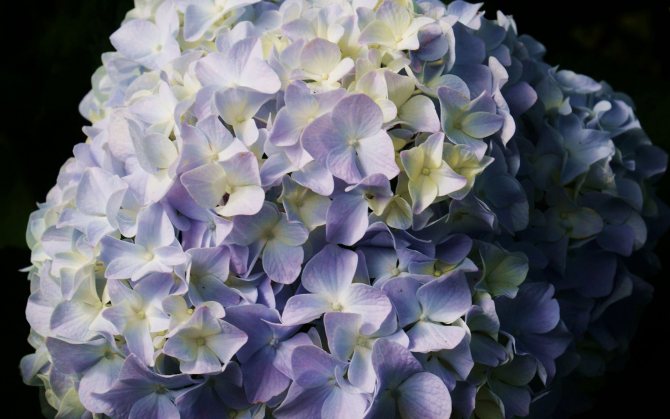

Garden hydrangea inflorescence
There is another version of the origin of the name of the flower, according to which it received its name in honor of the beautiful princess Hortense. She was the sister of one of the members of the French expedition around the world at the end of the 18th century. The members of this expedition discovered the plant in India and brought it from the island of Mauritius.
The plant got from Japan to Europe only in 1820. In 1900, breeders began to study it and work on obtaining new varieties. The first varieties were extremely thermophilic and were grown only as domestic ones. Today the genus Hortensia includes about 90 varieties, some of which have such an important property as resistance to various climatic conditions. It is these varieties that are suitable for growing in the harsh Siberian climate.
Garden hydrangea is a perennial wintering shrub of extraordinary beauty, the height of which can reach 2 m. During the flowering period, which on average lasts from May to September, large inflorescences are formed on the bush, reaching 30 cm in diameter. The number of inflorescences on one adult plant can be more than a hundred.
Plant flower descriptions
The hydrangea inflorescence is predominantly spherical. Each consists of two types of flowers: the first are small fertile, located in the center, the second are large sterile (sterile), placed at the edges of the inflorescence. In some species, only fertile flowers are present.
Most varieties have flowers that are exclusively white, but there are hybrids in other colors: cream, blue, red, lilac and pinkish.
For your information! The color also depends on the level of acidity of the soil. A neutral pH will give a cream or white color, soil with a high alkali content will give the buds a pink or lilac hue, and an acidic soil will give a blue color due to its high aluminum content, which hydrangea easily absorbs into itself.
The fruit of the flower is a box with 2-5 chambers containing small seeds.



